Business Plan for Installing Practice Management Software in a Local Healthcare Facility
VerifiedAdded on 2022/10/12
|29
|6458
|299
AI Summary
This business plan focuses on the advantages, risks, cost and funding, as well as reason for installing practice management software in a local healthcare facility. It elaborates on the change management process that can be introduced as well as some recommendations that would better the software’s functionality.
Contribute Materials
Your contribution can guide someone’s learning journey. Share your
documents today.
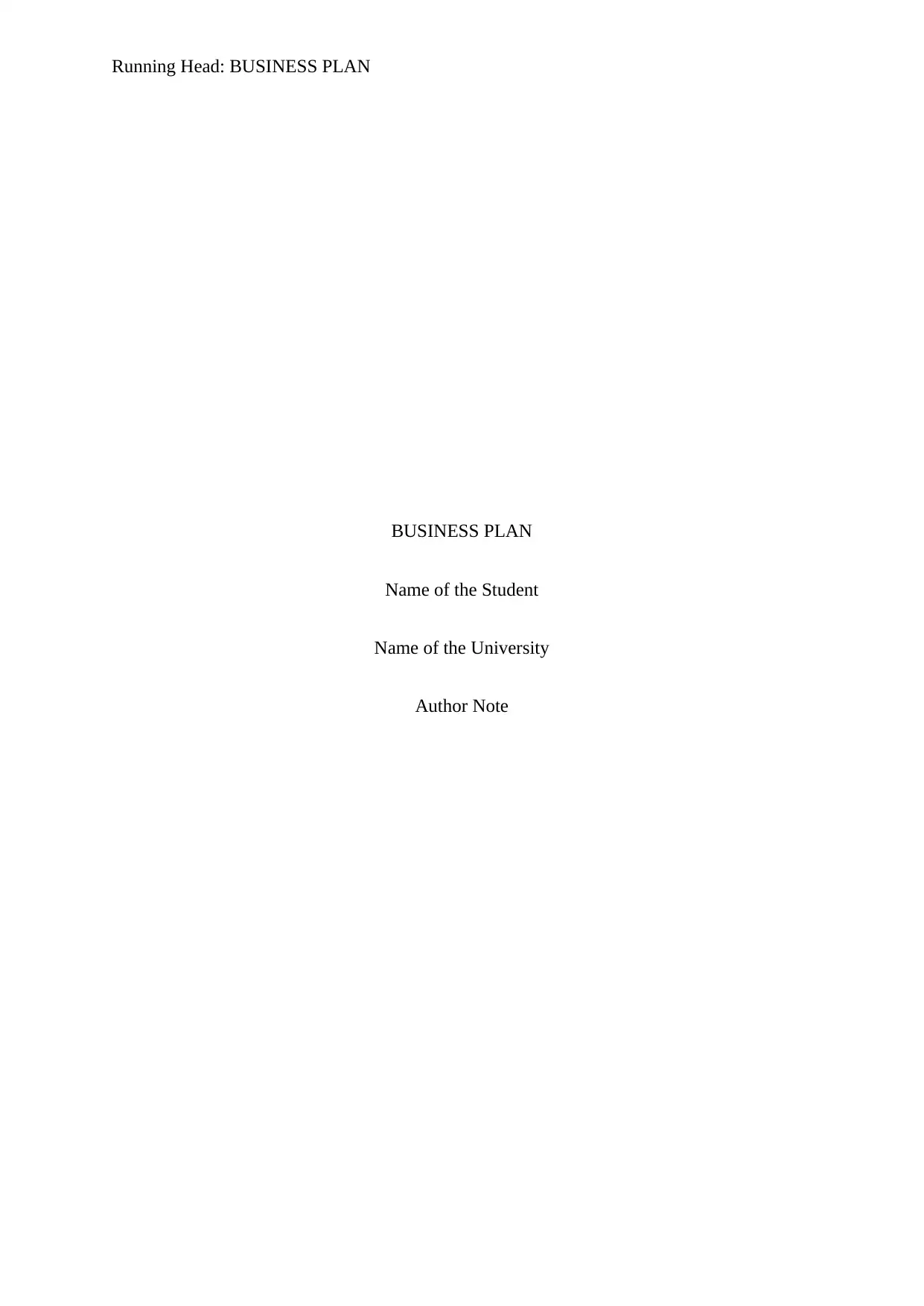
Running Head: BUSINESS PLAN
BUSINESS PLAN
Name of the Student
Name of the University
Author Note
BUSINESS PLAN
Name of the Student
Name of the University
Author Note
Secure Best Marks with AI Grader
Need help grading? Try our AI Grader for instant feedback on your assignments.
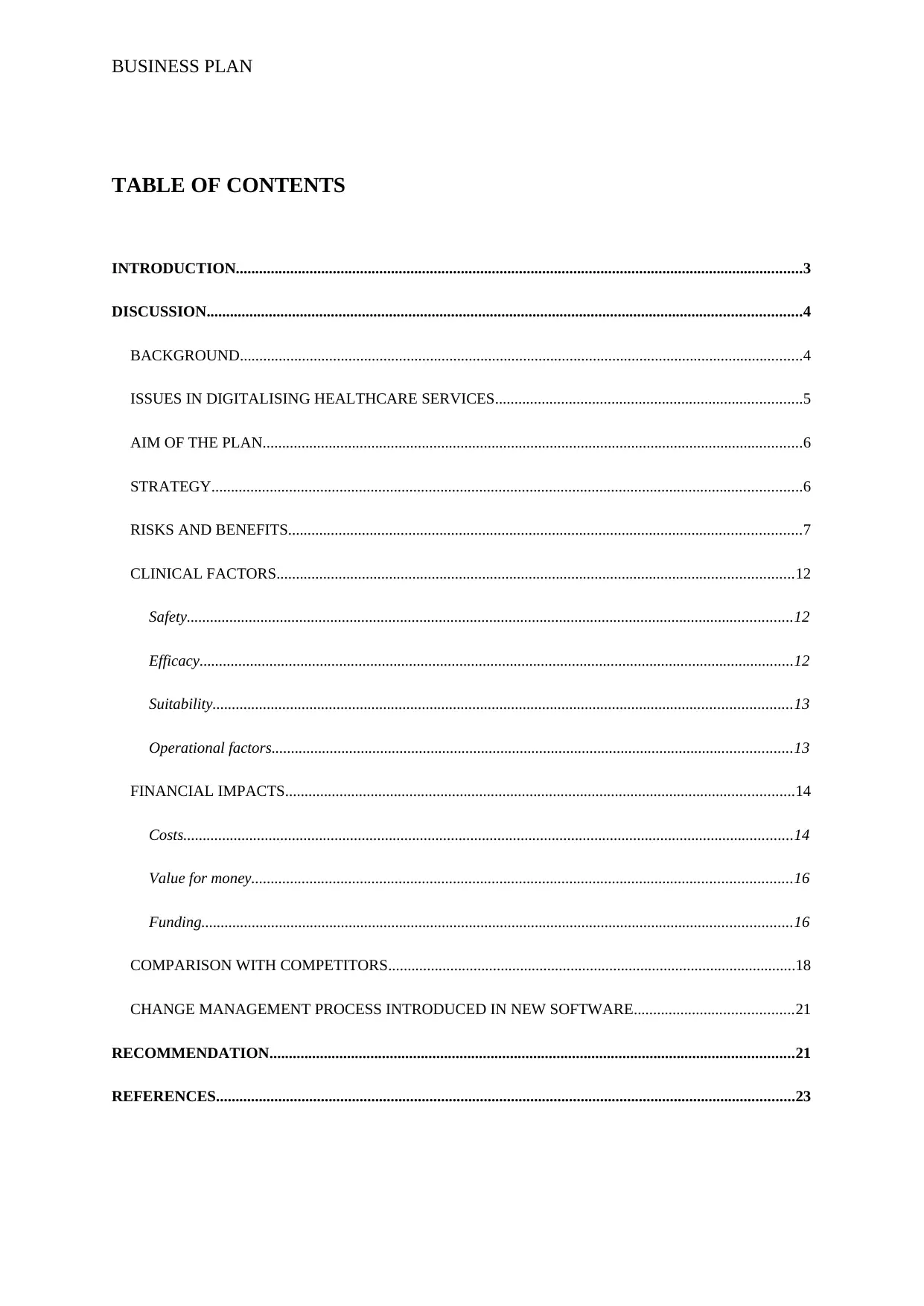
BUSINESS PLAN
TABLE OF CONTENTS
INTRODUCTION..................................................................................................................................................3
DISCUSSION.........................................................................................................................................................4
BACKGROUND.................................................................................................................................................4
ISSUES IN DIGITALISING HEALTHCARE SERVICES...............................................................................5
AIM OF THE PLAN...........................................................................................................................................6
STRATEGY........................................................................................................................................................6
RISKS AND BENEFITS....................................................................................................................................7
CLINICAL FACTORS.....................................................................................................................................12
Safety............................................................................................................................................................12
Efficacy.........................................................................................................................................................12
Suitability.....................................................................................................................................................13
Operational factors......................................................................................................................................13
FINANCIAL IMPACTS...................................................................................................................................14
Costs.............................................................................................................................................................14
Value for money...........................................................................................................................................16
Funding........................................................................................................................................................16
COMPARISON WITH COMPETITORS.........................................................................................................18
CHANGE MANAGEMENT PROCESS INTRODUCED IN NEW SOFTWARE.........................................21
RECOMMENDATION.......................................................................................................................................21
REFERENCES.....................................................................................................................................................23
TABLE OF CONTENTS
INTRODUCTION..................................................................................................................................................3
DISCUSSION.........................................................................................................................................................4
BACKGROUND.................................................................................................................................................4
ISSUES IN DIGITALISING HEALTHCARE SERVICES...............................................................................5
AIM OF THE PLAN...........................................................................................................................................6
STRATEGY........................................................................................................................................................6
RISKS AND BENEFITS....................................................................................................................................7
CLINICAL FACTORS.....................................................................................................................................12
Safety............................................................................................................................................................12
Efficacy.........................................................................................................................................................12
Suitability.....................................................................................................................................................13
Operational factors......................................................................................................................................13
FINANCIAL IMPACTS...................................................................................................................................14
Costs.............................................................................................................................................................14
Value for money...........................................................................................................................................16
Funding........................................................................................................................................................16
COMPARISON WITH COMPETITORS.........................................................................................................18
CHANGE MANAGEMENT PROCESS INTRODUCED IN NEW SOFTWARE.........................................21
RECOMMENDATION.......................................................................................................................................21
REFERENCES.....................................................................................................................................................23
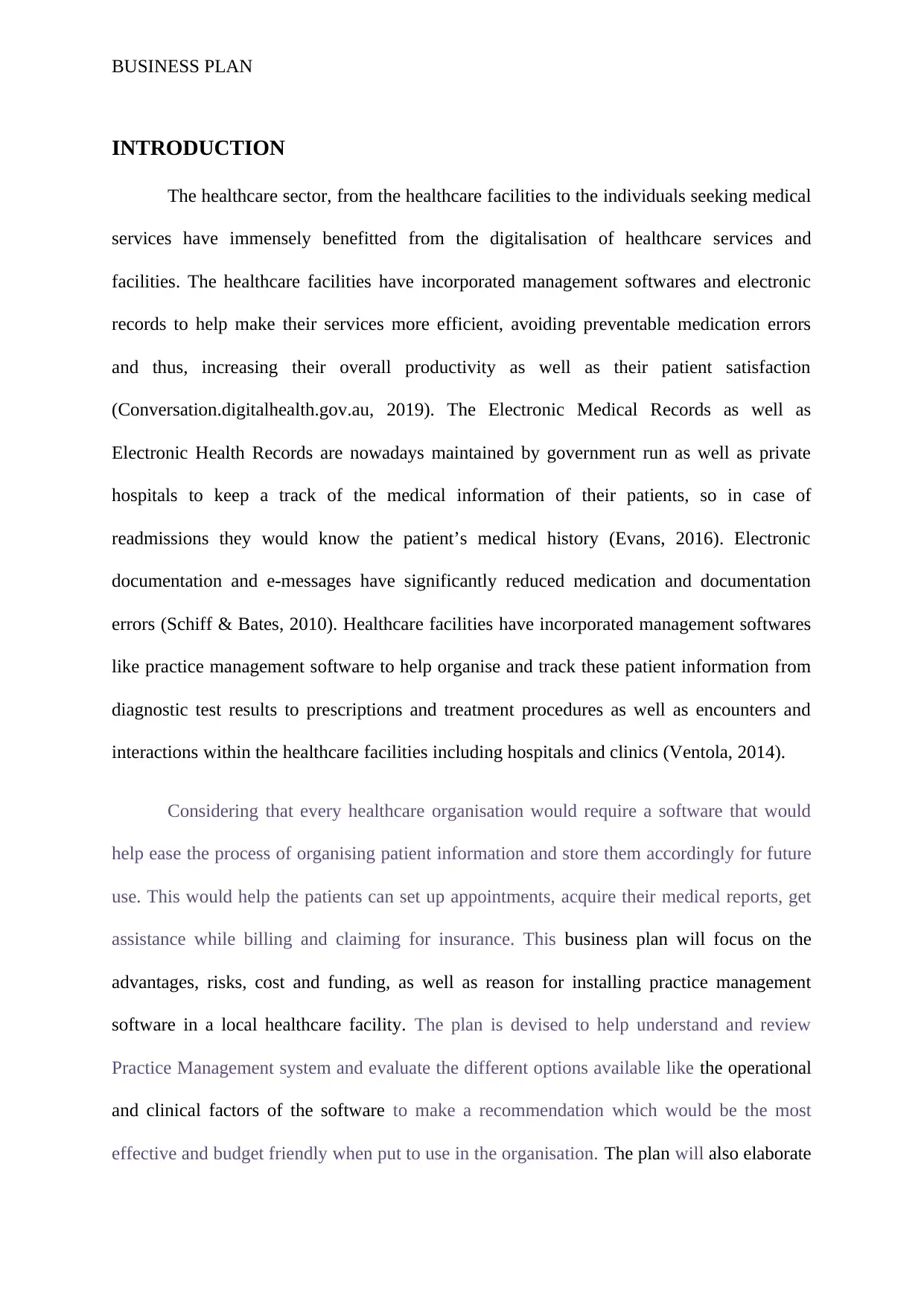
BUSINESS PLAN
INTRODUCTION
The healthcare sector, from the healthcare facilities to the individuals seeking medical
services have immensely benefitted from the digitalisation of healthcare services and
facilities. The healthcare facilities have incorporated management softwares and electronic
records to help make their services more efficient, avoiding preventable medication errors
and thus, increasing their overall productivity as well as their patient satisfaction
(Conversation.digitalhealth.gov.au, 2019). The Electronic Medical Records as well as
Electronic Health Records are nowadays maintained by government run as well as private
hospitals to keep a track of the medical information of their patients, so in case of
readmissions they would know the patient’s medical history (Evans, 2016). Electronic
documentation and e-messages have significantly reduced medication and documentation
errors (Schiff & Bates, 2010). Healthcare facilities have incorporated management softwares
like practice management software to help organise and track these patient information from
diagnostic test results to prescriptions and treatment procedures as well as encounters and
interactions within the healthcare facilities including hospitals and clinics (Ventola, 2014).
Considering that every healthcare organisation would require a software that would
help ease the process of organising patient information and store them accordingly for future
use. This would help the patients can set up appointments, acquire their medical reports, get
assistance while billing and claiming for insurance. This business plan will focus on the
advantages, risks, cost and funding, as well as reason for installing practice management
software in a local healthcare facility. The plan is devised to help understand and review
Practice Management system and evaluate the different options available like the operational
and clinical factors of the software to make a recommendation which would be the most
effective and budget friendly when put to use in the organisation. The plan will also elaborate
INTRODUCTION
The healthcare sector, from the healthcare facilities to the individuals seeking medical
services have immensely benefitted from the digitalisation of healthcare services and
facilities. The healthcare facilities have incorporated management softwares and electronic
records to help make their services more efficient, avoiding preventable medication errors
and thus, increasing their overall productivity as well as their patient satisfaction
(Conversation.digitalhealth.gov.au, 2019). The Electronic Medical Records as well as
Electronic Health Records are nowadays maintained by government run as well as private
hospitals to keep a track of the medical information of their patients, so in case of
readmissions they would know the patient’s medical history (Evans, 2016). Electronic
documentation and e-messages have significantly reduced medication and documentation
errors (Schiff & Bates, 2010). Healthcare facilities have incorporated management softwares
like practice management software to help organise and track these patient information from
diagnostic test results to prescriptions and treatment procedures as well as encounters and
interactions within the healthcare facilities including hospitals and clinics (Ventola, 2014).
Considering that every healthcare organisation would require a software that would
help ease the process of organising patient information and store them accordingly for future
use. This would help the patients can set up appointments, acquire their medical reports, get
assistance while billing and claiming for insurance. This business plan will focus on the
advantages, risks, cost and funding, as well as reason for installing practice management
software in a local healthcare facility. The plan is devised to help understand and review
Practice Management system and evaluate the different options available like the operational
and clinical factors of the software to make a recommendation which would be the most
effective and budget friendly when put to use in the organisation. The plan will also elaborate
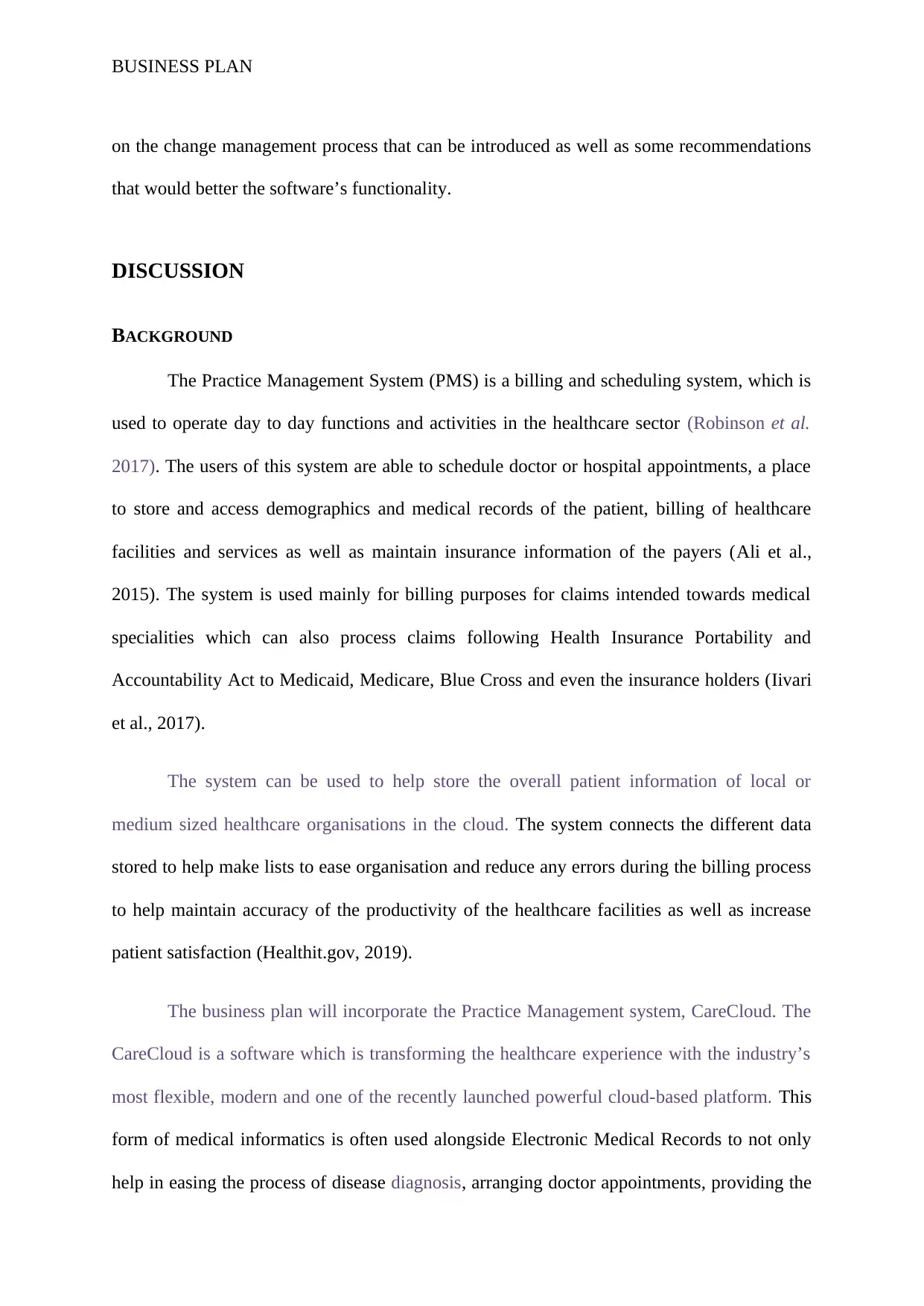
BUSINESS PLAN
on the change management process that can be introduced as well as some recommendations
that would better the software’s functionality.
DISCUSSION
BACKGROUND
The Practice Management System (PMS) is a billing and scheduling system, which is
used to operate day to day functions and activities in the healthcare sector (Robinson et al.
2017). The users of this system are able to schedule doctor or hospital appointments, a place
to store and access demographics and medical records of the patient, billing of healthcare
facilities and services as well as maintain insurance information of the payers (Ali et al.,
2015). The system is used mainly for billing purposes for claims intended towards medical
specialities which can also process claims following Health Insurance Portability and
Accountability Act to Medicaid, Medicare, Blue Cross and even the insurance holders (Iivari
et al., 2017).
The system can be used to help store the overall patient information of local or
medium sized healthcare organisations in the cloud. The system connects the different data
stored to help make lists to ease organisation and reduce any errors during the billing process
to help maintain accuracy of the productivity of the healthcare facilities as well as increase
patient satisfaction (Healthit.gov, 2019).
The business plan will incorporate the Practice Management system, CareCloud. The
CareCloud is a software which is transforming the healthcare experience with the industry’s
most flexible, modern and one of the recently launched powerful cloud-based platform. This
form of medical informatics is often used alongside Electronic Medical Records to not only
help in easing the process of disease diagnosis, arranging doctor appointments, providing the
on the change management process that can be introduced as well as some recommendations
that would better the software’s functionality.
DISCUSSION
BACKGROUND
The Practice Management System (PMS) is a billing and scheduling system, which is
used to operate day to day functions and activities in the healthcare sector (Robinson et al.
2017). The users of this system are able to schedule doctor or hospital appointments, a place
to store and access demographics and medical records of the patient, billing of healthcare
facilities and services as well as maintain insurance information of the payers (Ali et al.,
2015). The system is used mainly for billing purposes for claims intended towards medical
specialities which can also process claims following Health Insurance Portability and
Accountability Act to Medicaid, Medicare, Blue Cross and even the insurance holders (Iivari
et al., 2017).
The system can be used to help store the overall patient information of local or
medium sized healthcare organisations in the cloud. The system connects the different data
stored to help make lists to ease organisation and reduce any errors during the billing process
to help maintain accuracy of the productivity of the healthcare facilities as well as increase
patient satisfaction (Healthit.gov, 2019).
The business plan will incorporate the Practice Management system, CareCloud. The
CareCloud is a software which is transforming the healthcare experience with the industry’s
most flexible, modern and one of the recently launched powerful cloud-based platform. This
form of medical informatics is often used alongside Electronic Medical Records to not only
help in easing the process of disease diagnosis, arranging doctor appointments, providing the
Secure Best Marks with AI Grader
Need help grading? Try our AI Grader for instant feedback on your assignments.
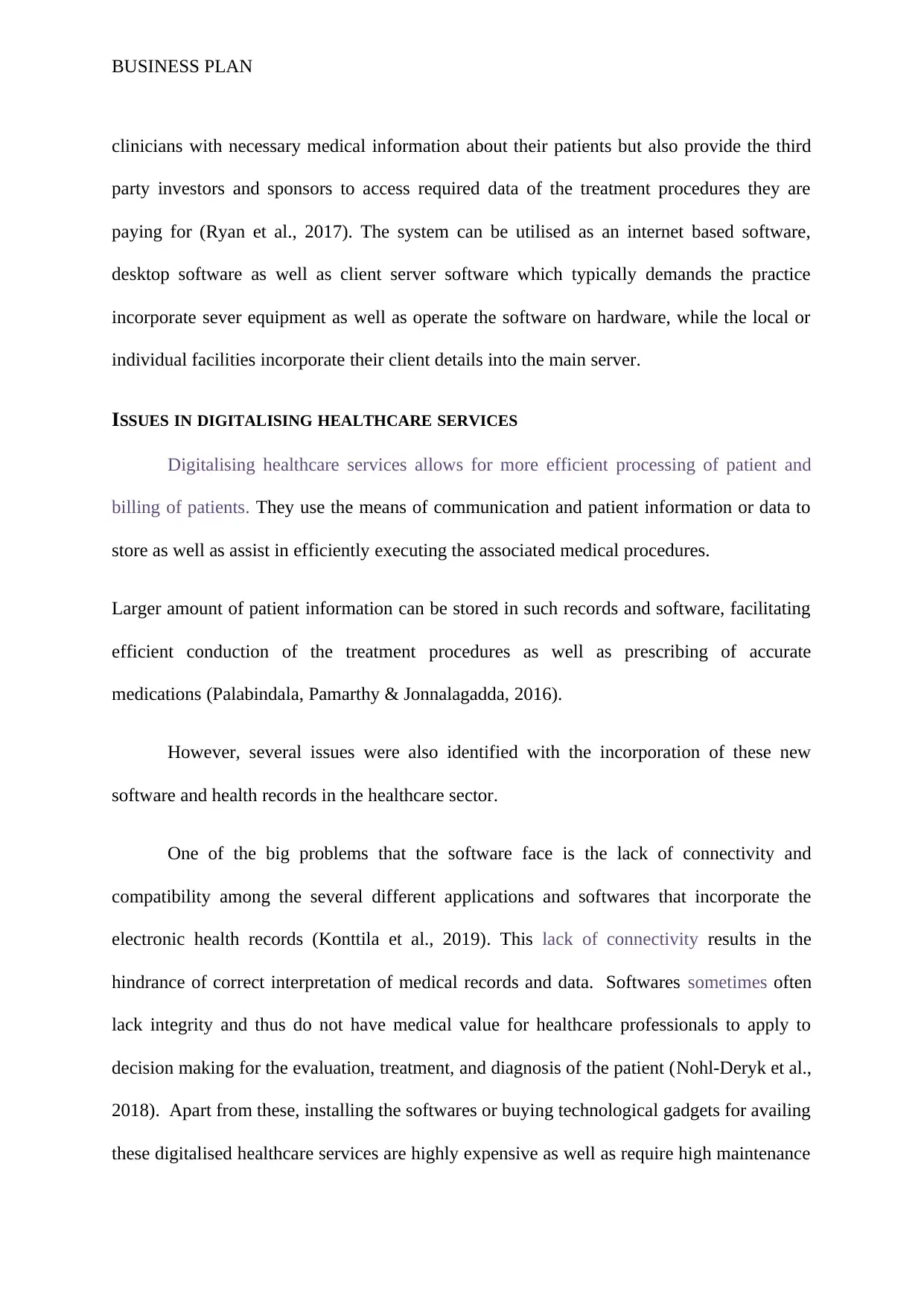
BUSINESS PLAN
clinicians with necessary medical information about their patients but also provide the third
party investors and sponsors to access required data of the treatment procedures they are
paying for (Ryan et al., 2017). The system can be utilised as an internet based software,
desktop software as well as client server software which typically demands the practice
incorporate sever equipment as well as operate the software on hardware, while the local or
individual facilities incorporate their client details into the main server.
ISSUES IN DIGITALISING HEALTHCARE SERVICES
Digitalising healthcare services allows for more efficient processing of patient and
billing of patients. They use the means of communication and patient information or data to
store as well as assist in efficiently executing the associated medical procedures.
Larger amount of patient information can be stored in such records and software, facilitating
efficient conduction of the treatment procedures as well as prescribing of accurate
medications (Palabindala, Pamarthy & Jonnalagadda, 2016).
However, several issues were also identified with the incorporation of these new
software and health records in the healthcare sector.
One of the big problems that the software face is the lack of connectivity and
compatibility among the several different applications and softwares that incorporate the
electronic health records (Konttila et al., 2019). This lack of connectivity results in the
hindrance of correct interpretation of medical records and data. Softwares sometimes often
lack integrity and thus do not have medical value for healthcare professionals to apply to
decision making for the evaluation, treatment, and diagnosis of the patient (Nohl-Deryk et al.,
2018). Apart from these, installing the softwares or buying technological gadgets for availing
these digitalised healthcare services are highly expensive as well as require high maintenance
clinicians with necessary medical information about their patients but also provide the third
party investors and sponsors to access required data of the treatment procedures they are
paying for (Ryan et al., 2017). The system can be utilised as an internet based software,
desktop software as well as client server software which typically demands the practice
incorporate sever equipment as well as operate the software on hardware, while the local or
individual facilities incorporate their client details into the main server.
ISSUES IN DIGITALISING HEALTHCARE SERVICES
Digitalising healthcare services allows for more efficient processing of patient and
billing of patients. They use the means of communication and patient information or data to
store as well as assist in efficiently executing the associated medical procedures.
Larger amount of patient information can be stored in such records and software, facilitating
efficient conduction of the treatment procedures as well as prescribing of accurate
medications (Palabindala, Pamarthy & Jonnalagadda, 2016).
However, several issues were also identified with the incorporation of these new
software and health records in the healthcare sector.
One of the big problems that the software face is the lack of connectivity and
compatibility among the several different applications and softwares that incorporate the
electronic health records (Konttila et al., 2019). This lack of connectivity results in the
hindrance of correct interpretation of medical records and data. Softwares sometimes often
lack integrity and thus do not have medical value for healthcare professionals to apply to
decision making for the evaluation, treatment, and diagnosis of the patient (Nohl-Deryk et al.,
2018). Apart from these, installing the softwares or buying technological gadgets for availing
these digitalised healthcare services are highly expensive as well as require high maintenance
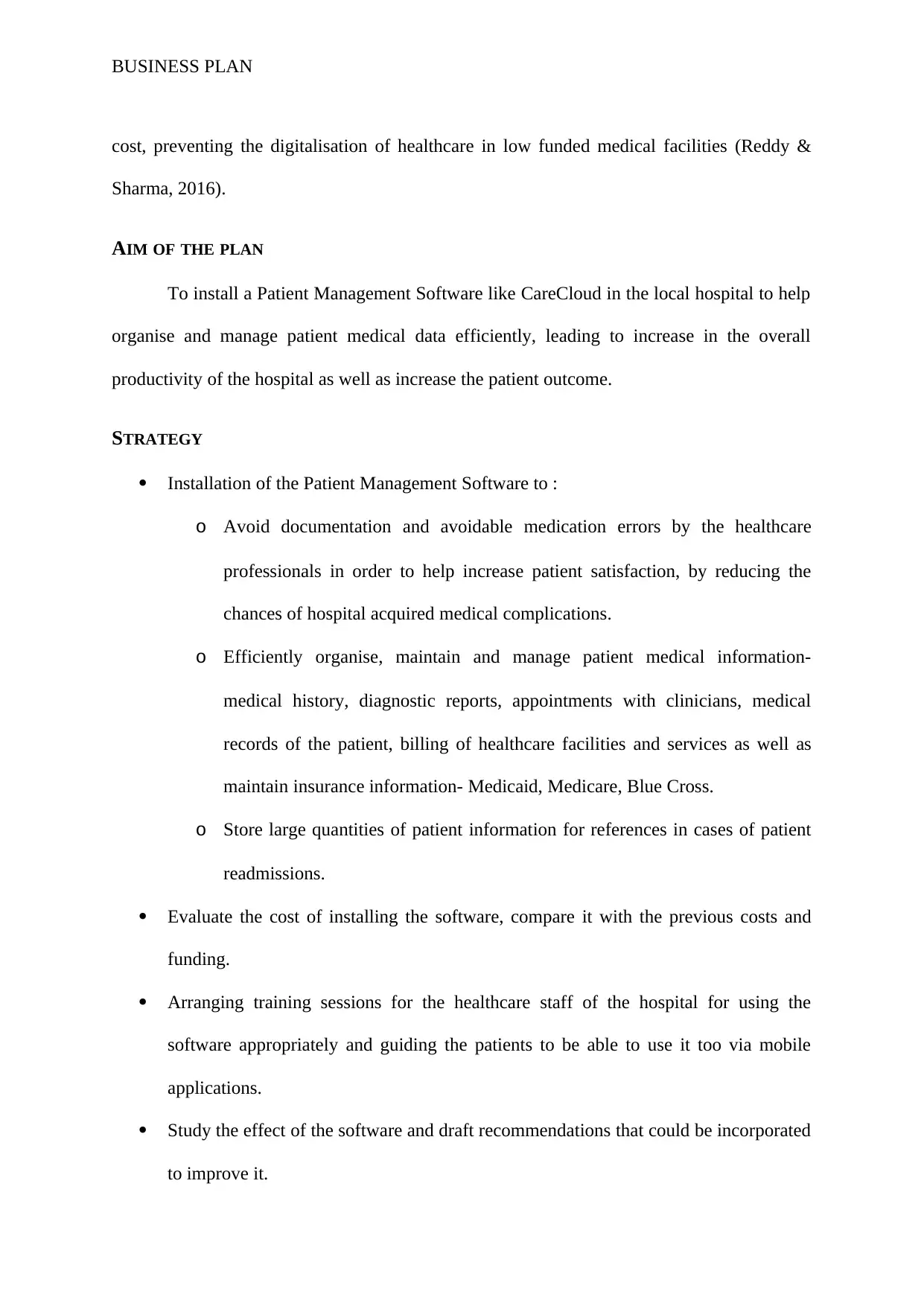
BUSINESS PLAN
cost, preventing the digitalisation of healthcare in low funded medical facilities (Reddy &
Sharma, 2016).
AIM OF THE PLAN
To install a Patient Management Software like CareCloud in the local hospital to help
organise and manage patient medical data efficiently, leading to increase in the overall
productivity of the hospital as well as increase the patient outcome.
STRATEGY
Installation of the Patient Management Software to :
o Avoid documentation and avoidable medication errors by the healthcare
professionals in order to help increase patient satisfaction, by reducing the
chances of hospital acquired medical complications.
o Efficiently organise, maintain and manage patient medical information-
medical history, diagnostic reports, appointments with clinicians, medical
records of the patient, billing of healthcare facilities and services as well as
maintain insurance information- Medicaid, Medicare, Blue Cross.
o Store large quantities of patient information for references in cases of patient
readmissions.
Evaluate the cost of installing the software, compare it with the previous costs and
funding.
Arranging training sessions for the healthcare staff of the hospital for using the
software appropriately and guiding the patients to be able to use it too via mobile
applications.
Study the effect of the software and draft recommendations that could be incorporated
to improve it.
cost, preventing the digitalisation of healthcare in low funded medical facilities (Reddy &
Sharma, 2016).
AIM OF THE PLAN
To install a Patient Management Software like CareCloud in the local hospital to help
organise and manage patient medical data efficiently, leading to increase in the overall
productivity of the hospital as well as increase the patient outcome.
STRATEGY
Installation of the Patient Management Software to :
o Avoid documentation and avoidable medication errors by the healthcare
professionals in order to help increase patient satisfaction, by reducing the
chances of hospital acquired medical complications.
o Efficiently organise, maintain and manage patient medical information-
medical history, diagnostic reports, appointments with clinicians, medical
records of the patient, billing of healthcare facilities and services as well as
maintain insurance information- Medicaid, Medicare, Blue Cross.
o Store large quantities of patient information for references in cases of patient
readmissions.
Evaluate the cost of installing the software, compare it with the previous costs and
funding.
Arranging training sessions for the healthcare staff of the hospital for using the
software appropriately and guiding the patients to be able to use it too via mobile
applications.
Study the effect of the software and draft recommendations that could be incorporated
to improve it.
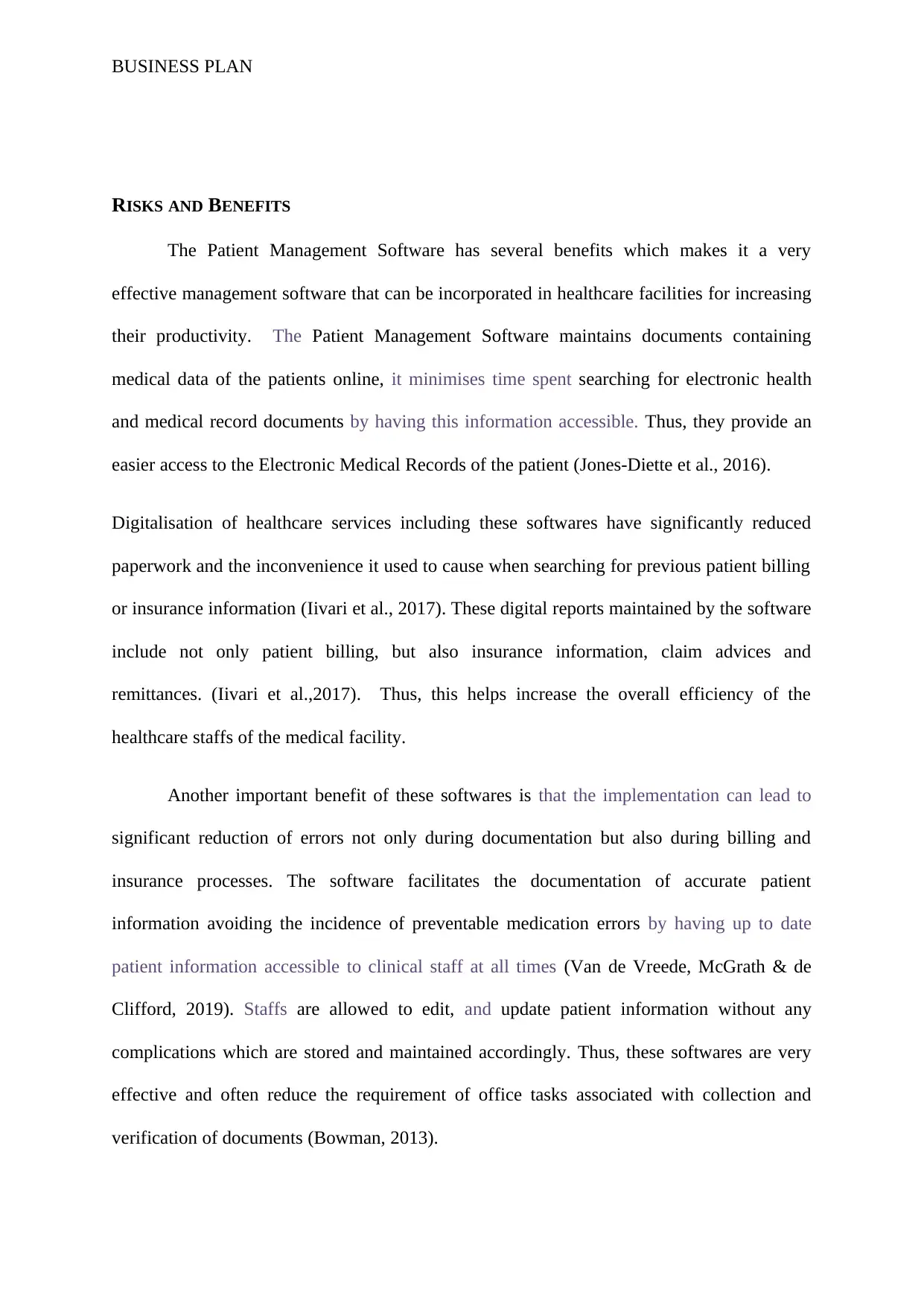
BUSINESS PLAN
RISKS AND BENEFITS
The Patient Management Software has several benefits which makes it a very
effective management software that can be incorporated in healthcare facilities for increasing
their productivity. The Patient Management Software maintains documents containing
medical data of the patients online, it minimises time spent searching for electronic health
and medical record documents by having this information accessible. Thus, they provide an
easier access to the Electronic Medical Records of the patient (Jones-Diette et al., 2016).
Digitalisation of healthcare services including these softwares have significantly reduced
paperwork and the inconvenience it used to cause when searching for previous patient billing
or insurance information (Iivari et al., 2017). These digital reports maintained by the software
include not only patient billing, but also insurance information, claim advices and
remittances. (Iivari et al.,2017). Thus, this helps increase the overall efficiency of the
healthcare staffs of the medical facility.
Another important benefit of these softwares is that the implementation can lead to
significant reduction of errors not only during documentation but also during billing and
insurance processes. The software facilitates the documentation of accurate patient
information avoiding the incidence of preventable medication errors by having up to date
patient information accessible to clinical staff at all times (Van de Vreede, McGrath & de
Clifford, 2019). Staffs are allowed to edit, and update patient information without any
complications which are stored and maintained accordingly. Thus, these softwares are very
effective and often reduce the requirement of office tasks associated with collection and
verification of documents (Bowman, 2013).
RISKS AND BENEFITS
The Patient Management Software has several benefits which makes it a very
effective management software that can be incorporated in healthcare facilities for increasing
their productivity. The Patient Management Software maintains documents containing
medical data of the patients online, it minimises time spent searching for electronic health
and medical record documents by having this information accessible. Thus, they provide an
easier access to the Electronic Medical Records of the patient (Jones-Diette et al., 2016).
Digitalisation of healthcare services including these softwares have significantly reduced
paperwork and the inconvenience it used to cause when searching for previous patient billing
or insurance information (Iivari et al., 2017). These digital reports maintained by the software
include not only patient billing, but also insurance information, claim advices and
remittances. (Iivari et al.,2017). Thus, this helps increase the overall efficiency of the
healthcare staffs of the medical facility.
Another important benefit of these softwares is that the implementation can lead to
significant reduction of errors not only during documentation but also during billing and
insurance processes. The software facilitates the documentation of accurate patient
information avoiding the incidence of preventable medication errors by having up to date
patient information accessible to clinical staff at all times (Van de Vreede, McGrath & de
Clifford, 2019). Staffs are allowed to edit, and update patient information without any
complications which are stored and maintained accordingly. Thus, these softwares are very
effective and often reduce the requirement of office tasks associated with collection and
verification of documents (Bowman, 2013).
Paraphrase This Document
Need a fresh take? Get an instant paraphrase of this document with our AI Paraphraser
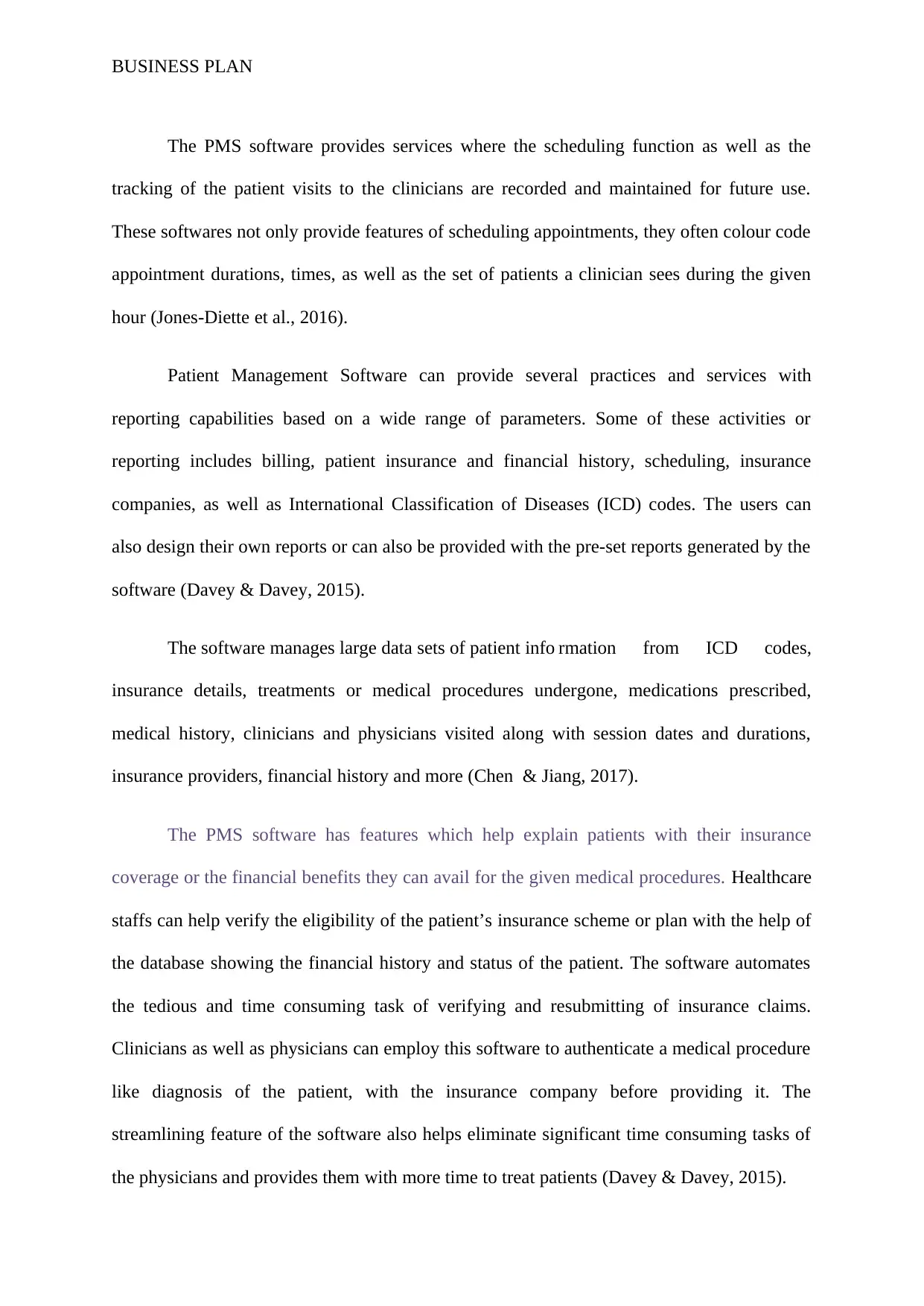
BUSINESS PLAN
The PMS software provides services where the scheduling function as well as the
tracking of the patient visits to the clinicians are recorded and maintained for future use.
These softwares not only provide features of scheduling appointments, they often colour code
appointment durations, times, as well as the set of patients a clinician sees during the given
hour (Jones-Diette et al., 2016).
Patient Management Software can provide several practices and services with
reporting capabilities based on a wide range of parameters. Some of these activities or
reporting includes billing, patient insurance and financial history, scheduling, insurance
companies, as well as International Classification of Diseases (ICD) codes. The users can
also design their own reports or can also be provided with the pre-set reports generated by the
software (Davey & Davey, 2015).
The software manages large data sets of patient info rmation from ICD codes,
insurance details, treatments or medical procedures undergone, medications prescribed,
medical history, clinicians and physicians visited along with session dates and durations,
insurance providers, financial history and more (Chen & Jiang, 2017).
The PMS software has features which help explain patients with their insurance
coverage or the financial benefits they can avail for the given medical procedures. Healthcare
staffs can help verify the eligibility of the patient’s insurance scheme or plan with the help of
the database showing the financial history and status of the patient. The software automates
the tedious and time consuming task of verifying and resubmitting of insurance claims.
Clinicians as well as physicians can employ this software to authenticate a medical procedure
like diagnosis of the patient, with the insurance company before providing it. The
streamlining feature of the software also helps eliminate significant time consuming tasks of
the physicians and provides them with more time to treat patients (Davey & Davey, 2015).
The PMS software provides services where the scheduling function as well as the
tracking of the patient visits to the clinicians are recorded and maintained for future use.
These softwares not only provide features of scheduling appointments, they often colour code
appointment durations, times, as well as the set of patients a clinician sees during the given
hour (Jones-Diette et al., 2016).
Patient Management Software can provide several practices and services with
reporting capabilities based on a wide range of parameters. Some of these activities or
reporting includes billing, patient insurance and financial history, scheduling, insurance
companies, as well as International Classification of Diseases (ICD) codes. The users can
also design their own reports or can also be provided with the pre-set reports generated by the
software (Davey & Davey, 2015).
The software manages large data sets of patient info rmation from ICD codes,
insurance details, treatments or medical procedures undergone, medications prescribed,
medical history, clinicians and physicians visited along with session dates and durations,
insurance providers, financial history and more (Chen & Jiang, 2017).
The PMS software has features which help explain patients with their insurance
coverage or the financial benefits they can avail for the given medical procedures. Healthcare
staffs can help verify the eligibility of the patient’s insurance scheme or plan with the help of
the database showing the financial history and status of the patient. The software automates
the tedious and time consuming task of verifying and resubmitting of insurance claims.
Clinicians as well as physicians can employ this software to authenticate a medical procedure
like diagnosis of the patient, with the insurance company before providing it. The
streamlining feature of the software also helps eliminate significant time consuming tasks of
the physicians and provides them with more time to treat patients (Davey & Davey, 2015).
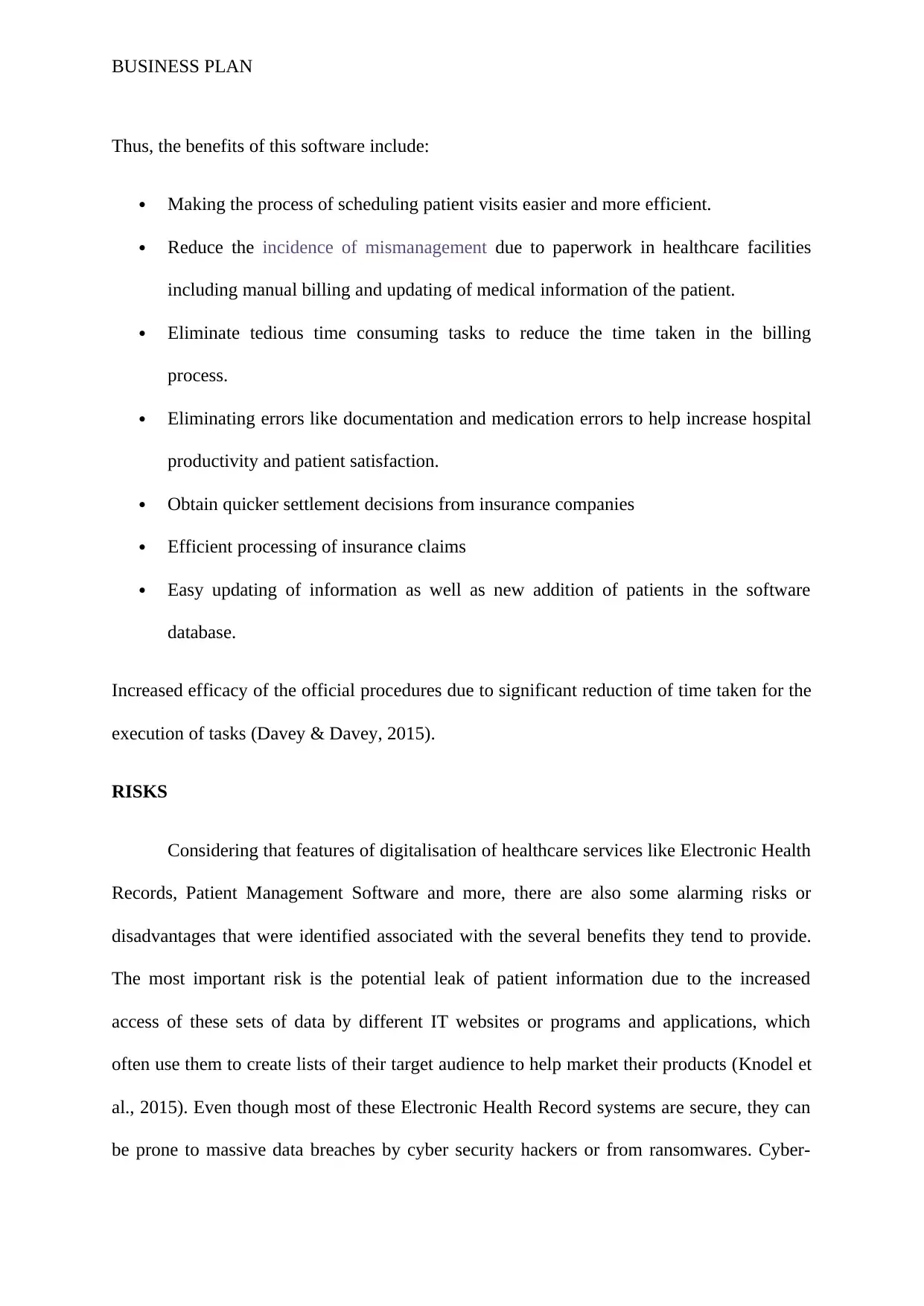
BUSINESS PLAN
Thus, the benefits of this software include:
Making the process of scheduling patient visits easier and more efficient.
Reduce the incidence of mismanagement due to paperwork in healthcare facilities
including manual billing and updating of medical information of the patient.
Eliminate tedious time consuming tasks to reduce the time taken in the billing
process.
Eliminating errors like documentation and medication errors to help increase hospital
productivity and patient satisfaction.
Obtain quicker settlement decisions from insurance companies
Efficient processing of insurance claims
Easy updating of information as well as new addition of patients in the software
database.
Increased efficacy of the official procedures due to significant reduction of time taken for the
execution of tasks (Davey & Davey, 2015).
RISKS
Considering that features of digitalisation of healthcare services like Electronic Health
Records, Patient Management Software and more, there are also some alarming risks or
disadvantages that were identified associated with the several benefits they tend to provide.
The most important risk is the potential leak of patient information due to the increased
access of these sets of data by different IT websites or programs and applications, which
often use them to create lists of their target audience to help market their products (Knodel et
al., 2015). Even though most of these Electronic Health Record systems are secure, they can
be prone to massive data breaches by cyber security hackers or from ransomwares. Cyber-
Thus, the benefits of this software include:
Making the process of scheduling patient visits easier and more efficient.
Reduce the incidence of mismanagement due to paperwork in healthcare facilities
including manual billing and updating of medical information of the patient.
Eliminate tedious time consuming tasks to reduce the time taken in the billing
process.
Eliminating errors like documentation and medication errors to help increase hospital
productivity and patient satisfaction.
Obtain quicker settlement decisions from insurance companies
Efficient processing of insurance claims
Easy updating of information as well as new addition of patients in the software
database.
Increased efficacy of the official procedures due to significant reduction of time taken for the
execution of tasks (Davey & Davey, 2015).
RISKS
Considering that features of digitalisation of healthcare services like Electronic Health
Records, Patient Management Software and more, there are also some alarming risks or
disadvantages that were identified associated with the several benefits they tend to provide.
The most important risk is the potential leak of patient information due to the increased
access of these sets of data by different IT websites or programs and applications, which
often use them to create lists of their target audience to help market their products (Knodel et
al., 2015). Even though most of these Electronic Health Record systems are secure, they can
be prone to massive data breaches by cyber security hackers or from ransomwares. Cyber-
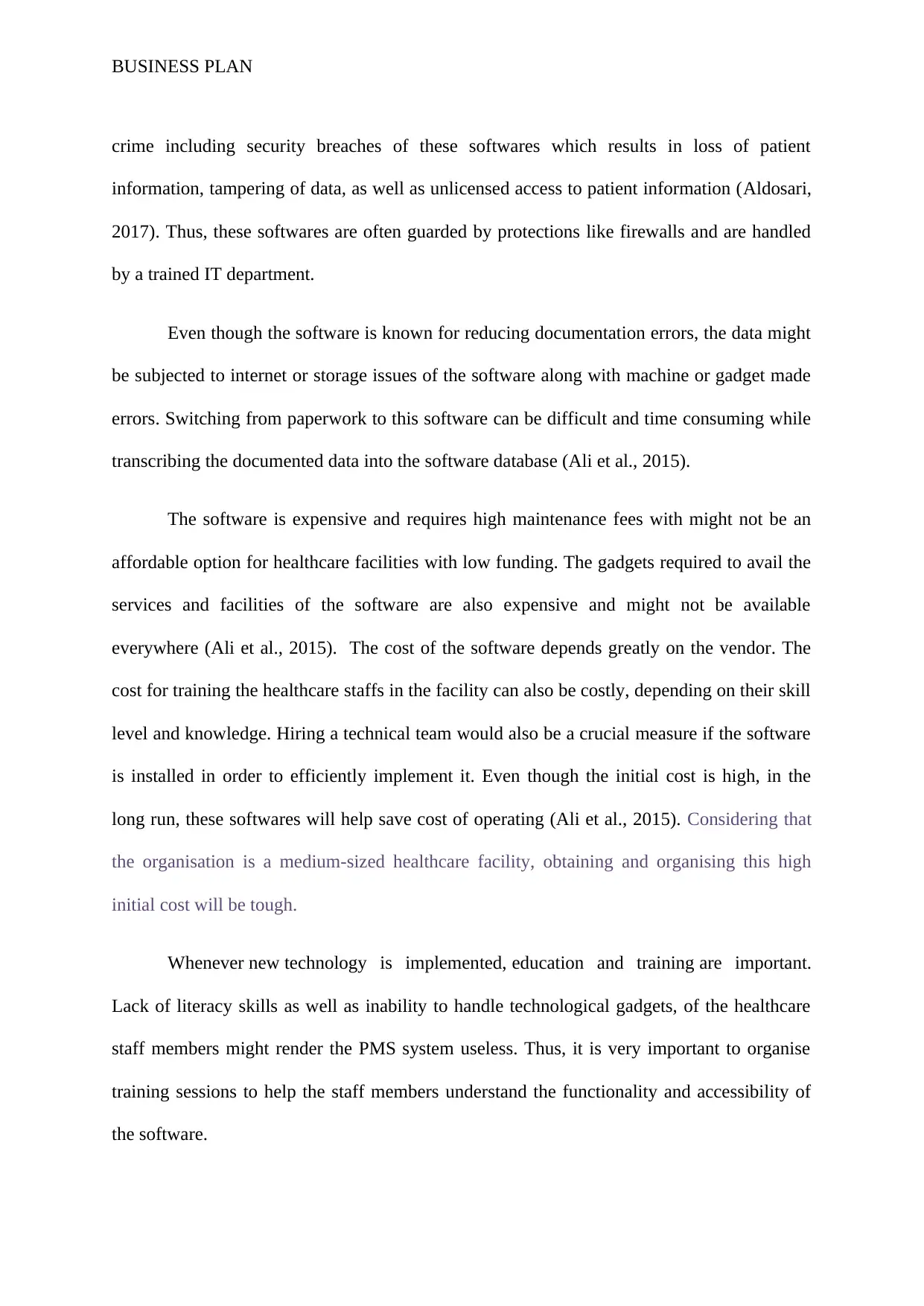
BUSINESS PLAN
crime including security breaches of these softwares which results in loss of patient
information, tampering of data, as well as unlicensed access to patient information (Aldosari,
2017). Thus, these softwares are often guarded by protections like firewalls and are handled
by a trained IT department.
Even though the software is known for reducing documentation errors, the data might
be subjected to internet or storage issues of the software along with machine or gadget made
errors. Switching from paperwork to this software can be difficult and time consuming while
transcribing the documented data into the software database (Ali et al., 2015).
The software is expensive and requires high maintenance fees with might not be an
affordable option for healthcare facilities with low funding. The gadgets required to avail the
services and facilities of the software are also expensive and might not be available
everywhere (Ali et al., 2015). The cost of the software depends greatly on the vendor. The
cost for training the healthcare staffs in the facility can also be costly, depending on their skill
level and knowledge. Hiring a technical team would also be a crucial measure if the software
is installed in order to efficiently implement it. Even though the initial cost is high, in the
long run, these softwares will help save cost of operating (Ali et al., 2015). Considering that
the organisation is a medium-sized healthcare facility, obtaining and organising this high
initial cost will be tough.
Whenever new technology is implemented, education and training are important.
Lack of literacy skills as well as inability to handle technological gadgets, of the healthcare
staff members might render the PMS system useless. Thus, it is very important to organise
training sessions to help the staff members understand the functionality and accessibility of
the software.
crime including security breaches of these softwares which results in loss of patient
information, tampering of data, as well as unlicensed access to patient information (Aldosari,
2017). Thus, these softwares are often guarded by protections like firewalls and are handled
by a trained IT department.
Even though the software is known for reducing documentation errors, the data might
be subjected to internet or storage issues of the software along with machine or gadget made
errors. Switching from paperwork to this software can be difficult and time consuming while
transcribing the documented data into the software database (Ali et al., 2015).
The software is expensive and requires high maintenance fees with might not be an
affordable option for healthcare facilities with low funding. The gadgets required to avail the
services and facilities of the software are also expensive and might not be available
everywhere (Ali et al., 2015). The cost of the software depends greatly on the vendor. The
cost for training the healthcare staffs in the facility can also be costly, depending on their skill
level and knowledge. Hiring a technical team would also be a crucial measure if the software
is installed in order to efficiently implement it. Even though the initial cost is high, in the
long run, these softwares will help save cost of operating (Ali et al., 2015). Considering that
the organisation is a medium-sized healthcare facility, obtaining and organising this high
initial cost will be tough.
Whenever new technology is implemented, education and training are important.
Lack of literacy skills as well as inability to handle technological gadgets, of the healthcare
staff members might render the PMS system useless. Thus, it is very important to organise
training sessions to help the staff members understand the functionality and accessibility of
the software.
Secure Best Marks with AI Grader
Need help grading? Try our AI Grader for instant feedback on your assignments.
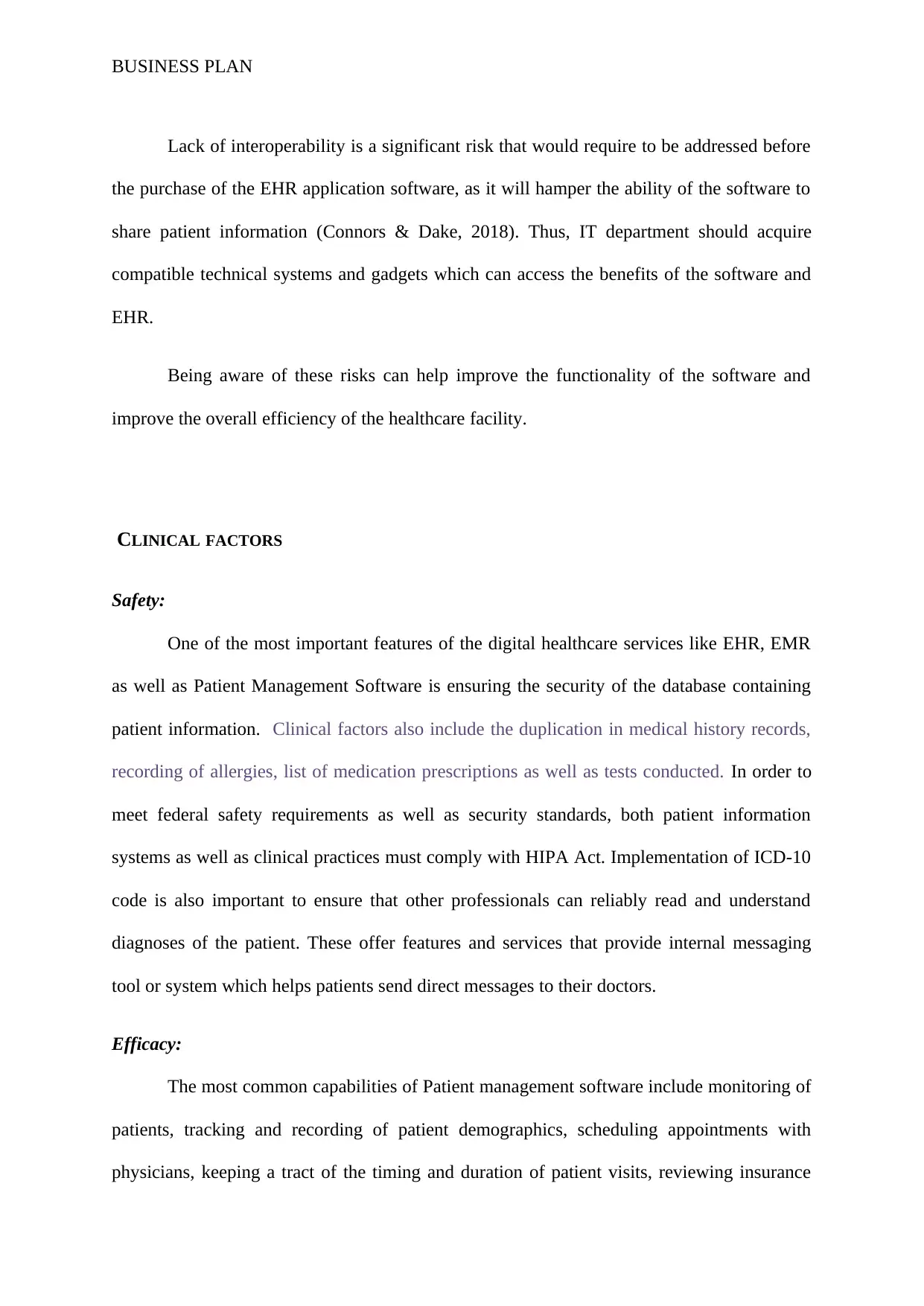
BUSINESS PLAN
Lack of interoperability is a significant risk that would require to be addressed before
the purchase of the EHR application software, as it will hamper the ability of the software to
share patient information (Connors & Dake, 2018). Thus, IT department should acquire
compatible technical systems and gadgets which can access the benefits of the software and
EHR.
Being aware of these risks can help improve the functionality of the software and
improve the overall efficiency of the healthcare facility.
CLINICAL FACTORS
Safety:
One of the most important features of the digital healthcare services like EHR, EMR
as well as Patient Management Software is ensuring the security of the database containing
patient information. Clinical factors also include the duplication in medical history records,
recording of allergies, list of medication prescriptions as well as tests conducted. In order to
meet federal safety requirements as well as security standards, both patient information
systems as well as clinical practices must comply with HIPA Act. Implementation of ICD-10
code is also important to ensure that other professionals can reliably read and understand
diagnoses of the patient. These offer features and services that provide internal messaging
tool or system which helps patients send direct messages to their doctors.
Efficacy:
The most common capabilities of Patient management software include monitoring of
patients, tracking and recording of patient demographics, scheduling appointments with
physicians, keeping a tract of the timing and duration of patient visits, reviewing insurance
Lack of interoperability is a significant risk that would require to be addressed before
the purchase of the EHR application software, as it will hamper the ability of the software to
share patient information (Connors & Dake, 2018). Thus, IT department should acquire
compatible technical systems and gadgets which can access the benefits of the software and
EHR.
Being aware of these risks can help improve the functionality of the software and
improve the overall efficiency of the healthcare facility.
CLINICAL FACTORS
Safety:
One of the most important features of the digital healthcare services like EHR, EMR
as well as Patient Management Software is ensuring the security of the database containing
patient information. Clinical factors also include the duplication in medical history records,
recording of allergies, list of medication prescriptions as well as tests conducted. In order to
meet federal safety requirements as well as security standards, both patient information
systems as well as clinical practices must comply with HIPA Act. Implementation of ICD-10
code is also important to ensure that other professionals can reliably read and understand
diagnoses of the patient. These offer features and services that provide internal messaging
tool or system which helps patients send direct messages to their doctors.
Efficacy:
The most common capabilities of Patient management software include monitoring of
patients, tracking and recording of patient demographics, scheduling appointments with
physicians, keeping a tract of the timing and duration of patient visits, reviewing insurance
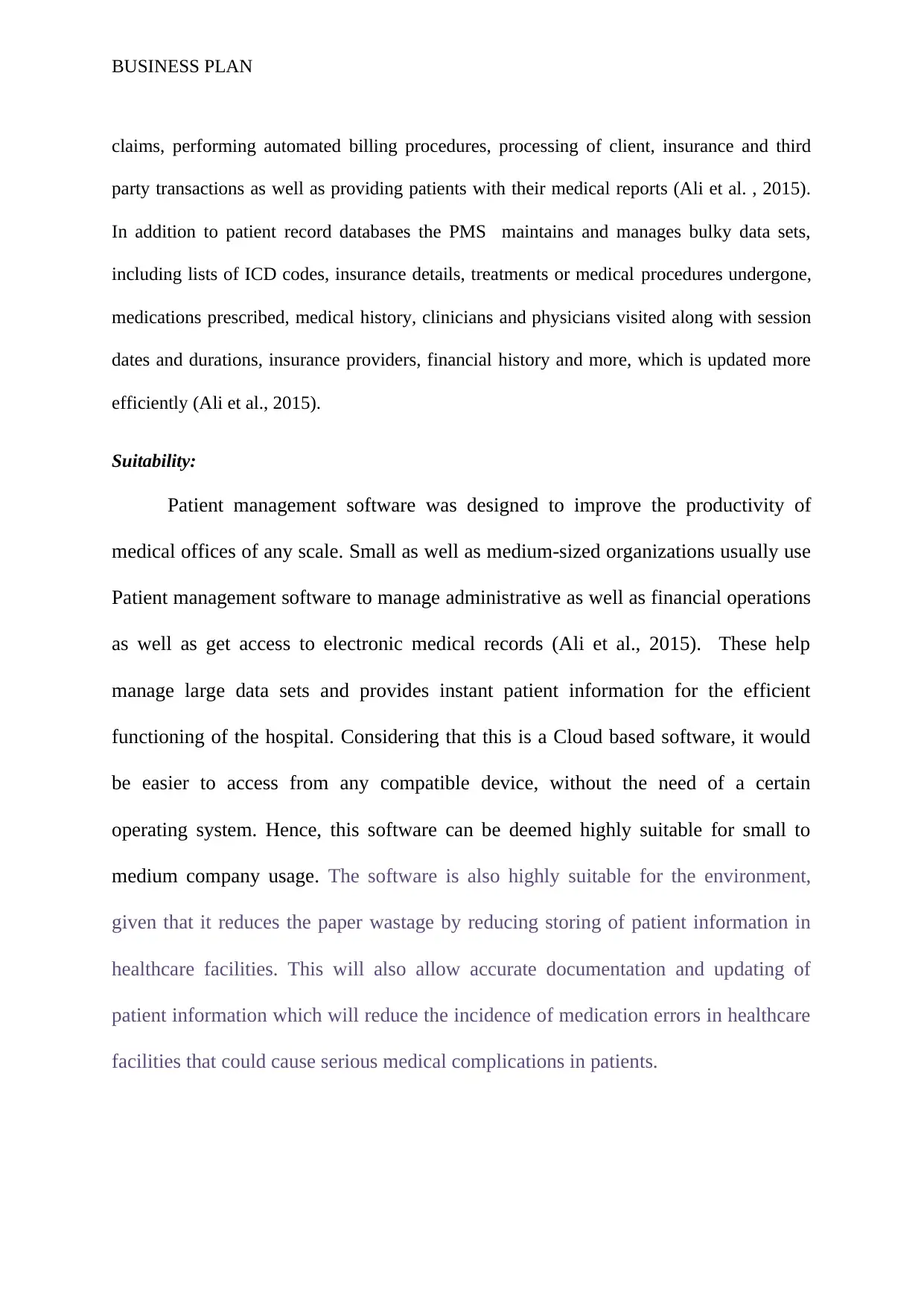
BUSINESS PLAN
claims, performing automated billing procedures, processing of client, insurance and third
party transactions as well as providing patients with their medical reports (Ali et al. , 2015).
In addition to patient record databases the PMS maintains and manages bulky data sets,
including lists of ICD codes, insurance details, treatments or medical procedures undergone,
medications prescribed, medical history, clinicians and physicians visited along with session
dates and durations, insurance providers, financial history and more, which is updated more
efficiently (Ali et al., 2015).
Suitability:
Patient management software was designed to improve the productivity of
medical offices of any scale. Small as well as medium-sized organizations usually use
Patient management software to manage administrative as well as financial operations
as well as get access to electronic medical records (Ali et al., 2015). These help
manage large data sets and provides instant patient information for the efficient
functioning of the hospital. Considering that this is a Cloud based software, it would
be easier to access from any compatible device, without the need of a certain
operating system. Hence, this software can be deemed highly suitable for small to
medium company usage. The software is also highly suitable for the environment,
given that it reduces the paper wastage by reducing storing of patient information in
healthcare facilities. This will also allow accurate documentation and updating of
patient information which will reduce the incidence of medication errors in healthcare
facilities that could cause serious medical complications in patients.
claims, performing automated billing procedures, processing of client, insurance and third
party transactions as well as providing patients with their medical reports (Ali et al. , 2015).
In addition to patient record databases the PMS maintains and manages bulky data sets,
including lists of ICD codes, insurance details, treatments or medical procedures undergone,
medications prescribed, medical history, clinicians and physicians visited along with session
dates and durations, insurance providers, financial history and more, which is updated more
efficiently (Ali et al., 2015).
Suitability:
Patient management software was designed to improve the productivity of
medical offices of any scale. Small as well as medium-sized organizations usually use
Patient management software to manage administrative as well as financial operations
as well as get access to electronic medical records (Ali et al., 2015). These help
manage large data sets and provides instant patient information for the efficient
functioning of the hospital. Considering that this is a Cloud based software, it would
be easier to access from any compatible device, without the need of a certain
operating system. Hence, this software can be deemed highly suitable for small to
medium company usage. The software is also highly suitable for the environment,
given that it reduces the paper wastage by reducing storing of patient information in
healthcare facilities. This will also allow accurate documentation and updating of
patient information which will reduce the incidence of medication errors in healthcare
facilities that could cause serious medical complications in patients.
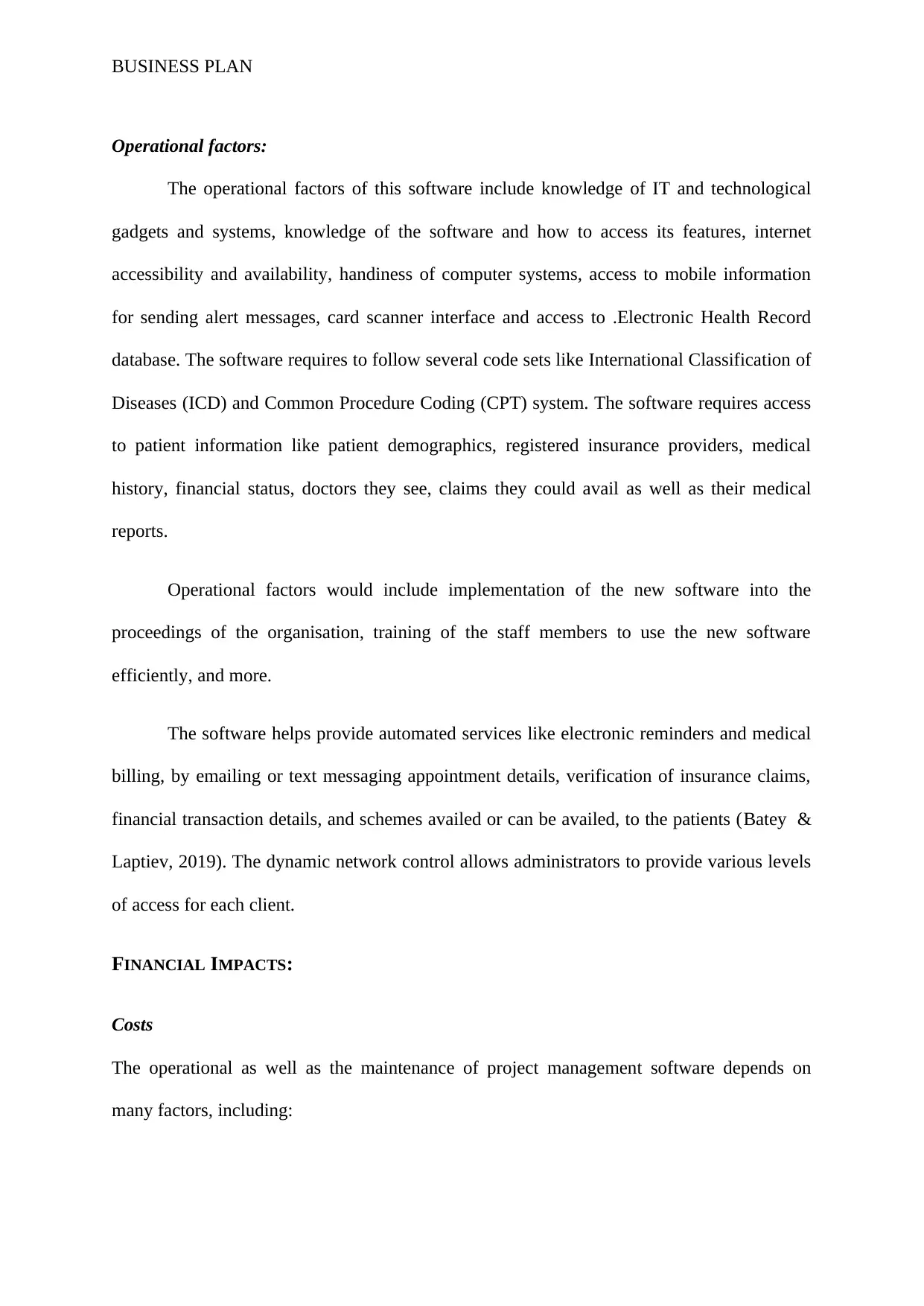
BUSINESS PLAN
Operational factors:
The operational factors of this software include knowledge of IT and technological
gadgets and systems, knowledge of the software and how to access its features, internet
accessibility and availability, handiness of computer systems, access to mobile information
for sending alert messages, card scanner interface and access to .Electronic Health Record
database. The software requires to follow several code sets like International Classification of
Diseases (ICD) and Common Procedure Coding (CPT) system. The software requires access
to patient information like patient demographics, registered insurance providers, medical
history, financial status, doctors they see, claims they could avail as well as their medical
reports.
Operational factors would include implementation of the new software into the
proceedings of the organisation, training of the staff members to use the new software
efficiently, and more.
The software helps provide automated services like electronic reminders and medical
billing, by emailing or text messaging appointment details, verification of insurance claims,
financial transaction details, and schemes availed or can be availed, to the patients (Batey &
Laptiev, 2019). The dynamic network control allows administrators to provide various levels
of access for each client.
FINANCIAL IMPACTS:
Costs
The operational as well as the maintenance of project management software depends on
many factors, including:
Operational factors:
The operational factors of this software include knowledge of IT and technological
gadgets and systems, knowledge of the software and how to access its features, internet
accessibility and availability, handiness of computer systems, access to mobile information
for sending alert messages, card scanner interface and access to .Electronic Health Record
database. The software requires to follow several code sets like International Classification of
Diseases (ICD) and Common Procedure Coding (CPT) system. The software requires access
to patient information like patient demographics, registered insurance providers, medical
history, financial status, doctors they see, claims they could avail as well as their medical
reports.
Operational factors would include implementation of the new software into the
proceedings of the organisation, training of the staff members to use the new software
efficiently, and more.
The software helps provide automated services like electronic reminders and medical
billing, by emailing or text messaging appointment details, verification of insurance claims,
financial transaction details, and schemes availed or can be availed, to the patients (Batey &
Laptiev, 2019). The dynamic network control allows administrators to provide various levels
of access for each client.
FINANCIAL IMPACTS:
Costs
The operational as well as the maintenance of project management software depends on
many factors, including:
Paraphrase This Document
Need a fresh take? Get an instant paraphrase of this document with our AI Paraphraser
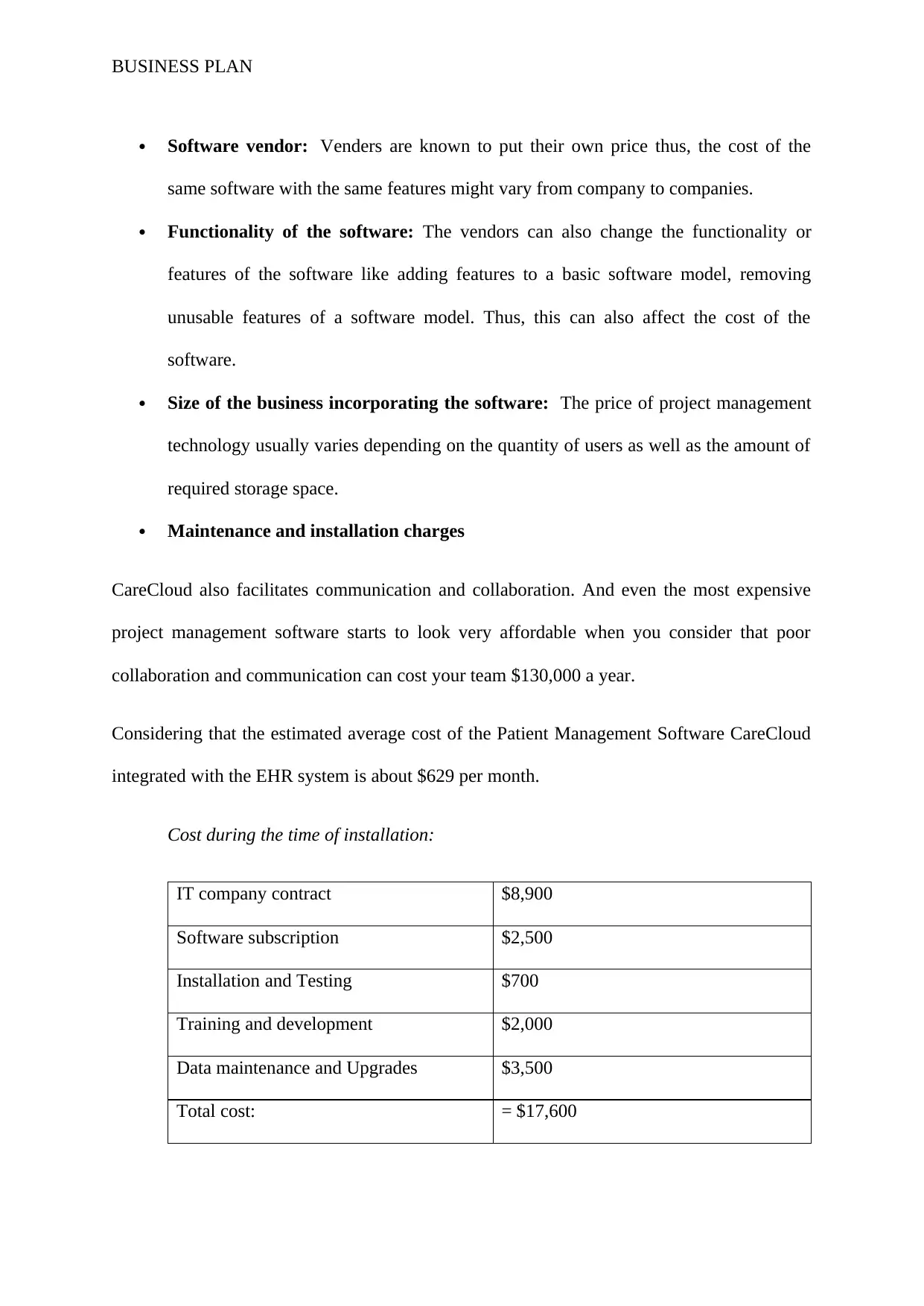
BUSINESS PLAN
Software vendor: Venders are known to put their own price thus, the cost of the
same software with the same features might vary from company to companies.
Functionality of the software: The vendors can also change the functionality or
features of the software like adding features to a basic software model, removing
unusable features of a software model. Thus, this can also affect the cost of the
software.
Size of the business incorporating the software: The price of project management
technology usually varies depending on the quantity of users as well as the amount of
required storage space.
Maintenance and installation charges
CareCloud also facilitates communication and collaboration. And even the most expensive
project management software starts to look very affordable when you consider that poor
collaboration and communication can cost your team $130,000 a year.
Considering that the estimated average cost of the Patient Management Software CareCloud
integrated with the EHR system is about $629 per month.
Cost during the time of installation:
IT company contract $8,900
Software subscription $2,500
Installation and Testing $700
Training and development $2,000
Data maintenance and Upgrades $3,500
Total cost: = $17,600
Software vendor: Venders are known to put their own price thus, the cost of the
same software with the same features might vary from company to companies.
Functionality of the software: The vendors can also change the functionality or
features of the software like adding features to a basic software model, removing
unusable features of a software model. Thus, this can also affect the cost of the
software.
Size of the business incorporating the software: The price of project management
technology usually varies depending on the quantity of users as well as the amount of
required storage space.
Maintenance and installation charges
CareCloud also facilitates communication and collaboration. And even the most expensive
project management software starts to look very affordable when you consider that poor
collaboration and communication can cost your team $130,000 a year.
Considering that the estimated average cost of the Patient Management Software CareCloud
integrated with the EHR system is about $629 per month.
Cost during the time of installation:
IT company contract $8,900
Software subscription $2,500
Installation and Testing $700
Training and development $2,000
Data maintenance and Upgrades $3,500
Total cost: = $17,600
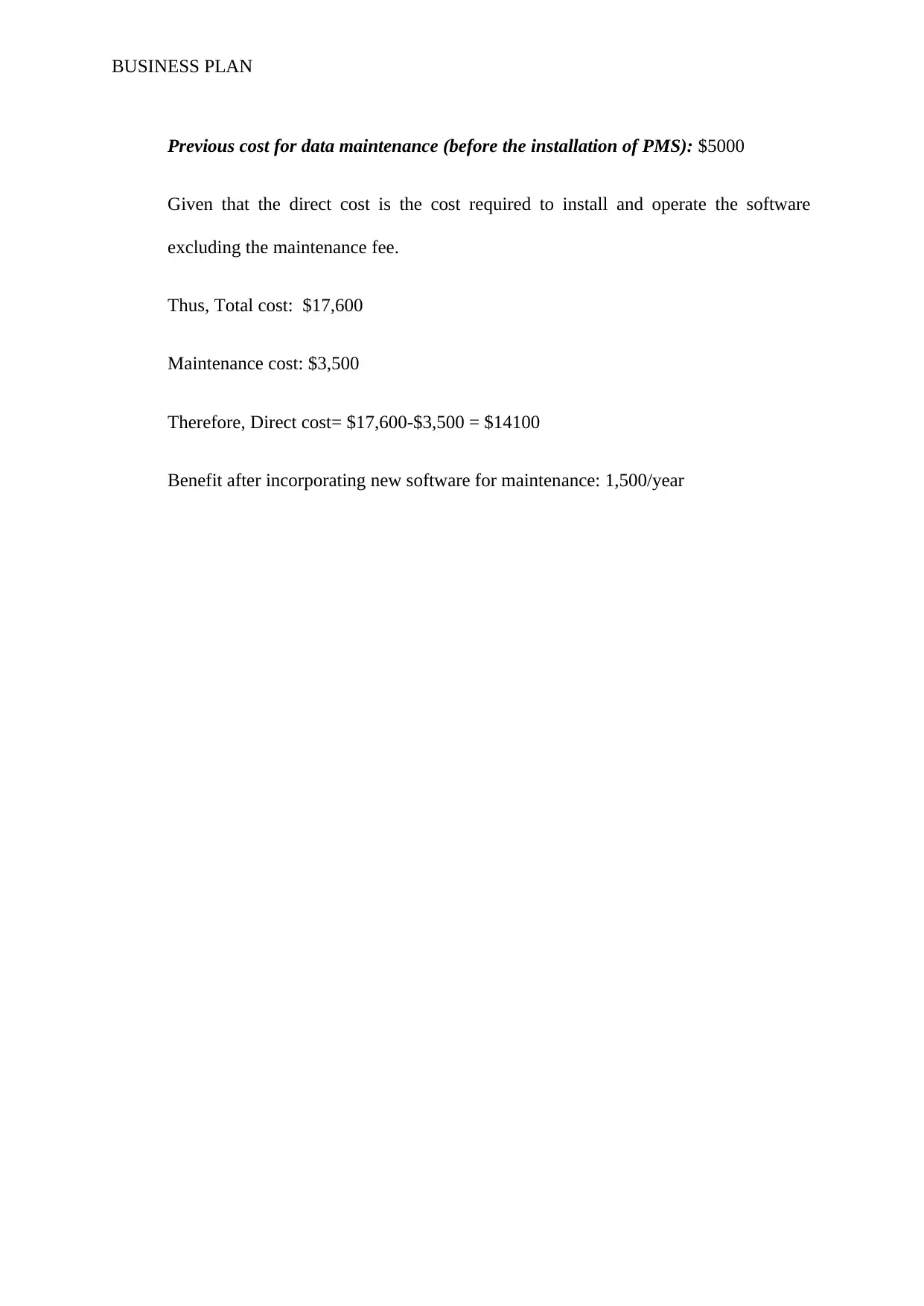
BUSINESS PLAN
Previous cost for data maintenance (before the installation of PMS): $5000
Given that the direct cost is the cost required to install and operate the software
excluding the maintenance fee.
Thus, Total cost: $17,600
Maintenance cost: $3,500
Therefore, Direct cost= $17,600-$3,500 = $14100
Benefit after incorporating new software for maintenance: 1,500/year
Previous cost for data maintenance (before the installation of PMS): $5000
Given that the direct cost is the cost required to install and operate the software
excluding the maintenance fee.
Thus, Total cost: $17,600
Maintenance cost: $3,500
Therefore, Direct cost= $17,600-$3,500 = $14100
Benefit after incorporating new software for maintenance: 1,500/year
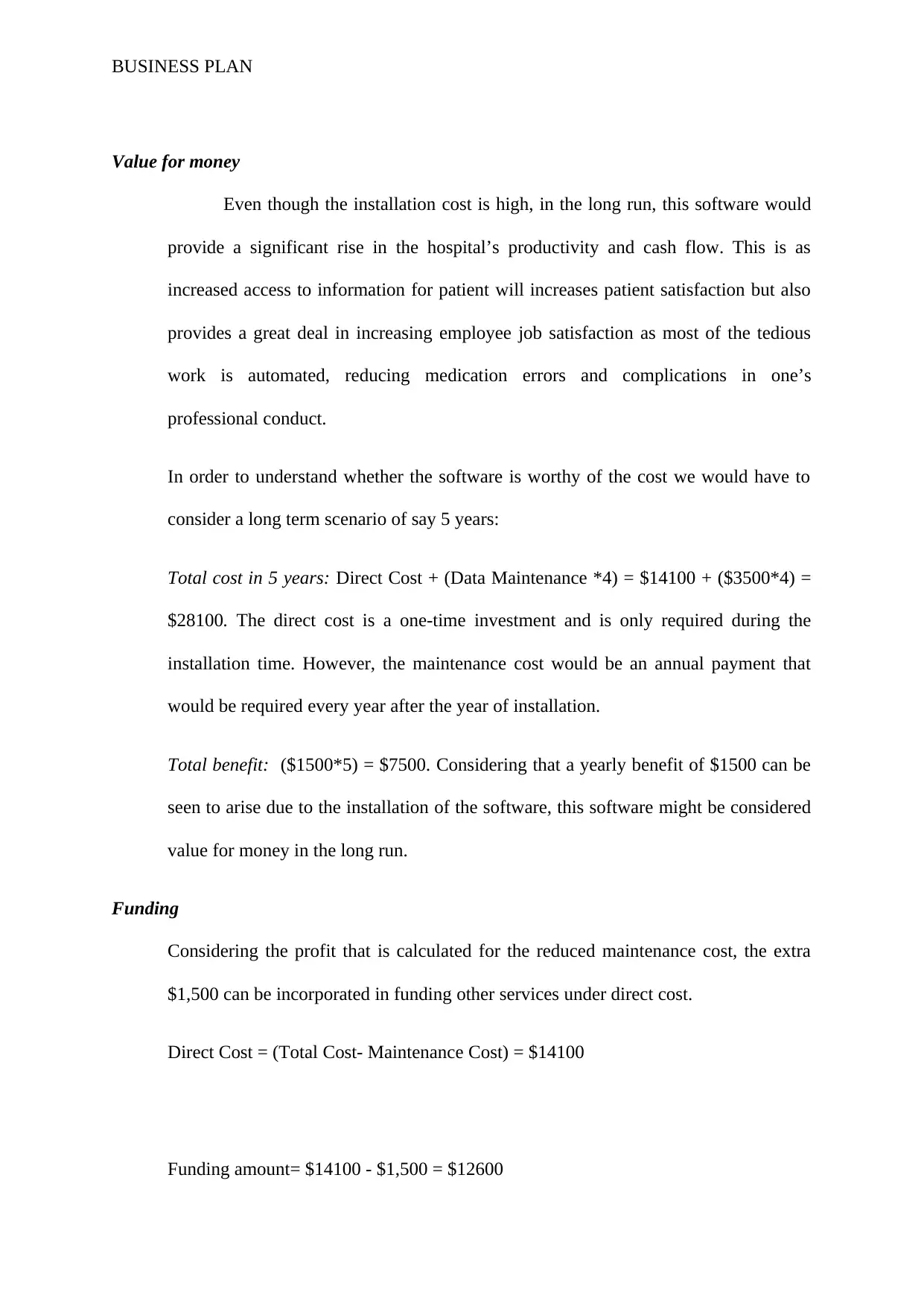
BUSINESS PLAN
Value for money
Even though the installation cost is high, in the long run, this software would
provide a significant rise in the hospital’s productivity and cash flow. This is as
increased access to information for patient will increases patient satisfaction but also
provides a great deal in increasing employee job satisfaction as most of the tedious
work is automated, reducing medication errors and complications in one’s
professional conduct.
In order to understand whether the software is worthy of the cost we would have to
consider a long term scenario of say 5 years:
Total cost in 5 years: Direct Cost + (Data Maintenance *4) = $14100 + ($3500*4) =
$28100. The direct cost is a one-time investment and is only required during the
installation time. However, the maintenance cost would be an annual payment that
would be required every year after the year of installation.
Total benefit: ($1500*5) = $7500. Considering that a yearly benefit of $1500 can be
seen to arise due to the installation of the software, this software might be considered
value for money in the long run.
Funding
Considering the profit that is calculated for the reduced maintenance cost, the extra
$1,500 can be incorporated in funding other services under direct cost.
Direct Cost = (Total Cost- Maintenance Cost) = $14100
Funding amount= $14100 - $1,500 = $12600
Value for money
Even though the installation cost is high, in the long run, this software would
provide a significant rise in the hospital’s productivity and cash flow. This is as
increased access to information for patient will increases patient satisfaction but also
provides a great deal in increasing employee job satisfaction as most of the tedious
work is automated, reducing medication errors and complications in one’s
professional conduct.
In order to understand whether the software is worthy of the cost we would have to
consider a long term scenario of say 5 years:
Total cost in 5 years: Direct Cost + (Data Maintenance *4) = $14100 + ($3500*4) =
$28100. The direct cost is a one-time investment and is only required during the
installation time. However, the maintenance cost would be an annual payment that
would be required every year after the year of installation.
Total benefit: ($1500*5) = $7500. Considering that a yearly benefit of $1500 can be
seen to arise due to the installation of the software, this software might be considered
value for money in the long run.
Funding
Considering the profit that is calculated for the reduced maintenance cost, the extra
$1,500 can be incorporated in funding other services under direct cost.
Direct Cost = (Total Cost- Maintenance Cost) = $14100
Funding amount= $14100 - $1,500 = $12600
Secure Best Marks with AI Grader
Need help grading? Try our AI Grader for instant feedback on your assignments.
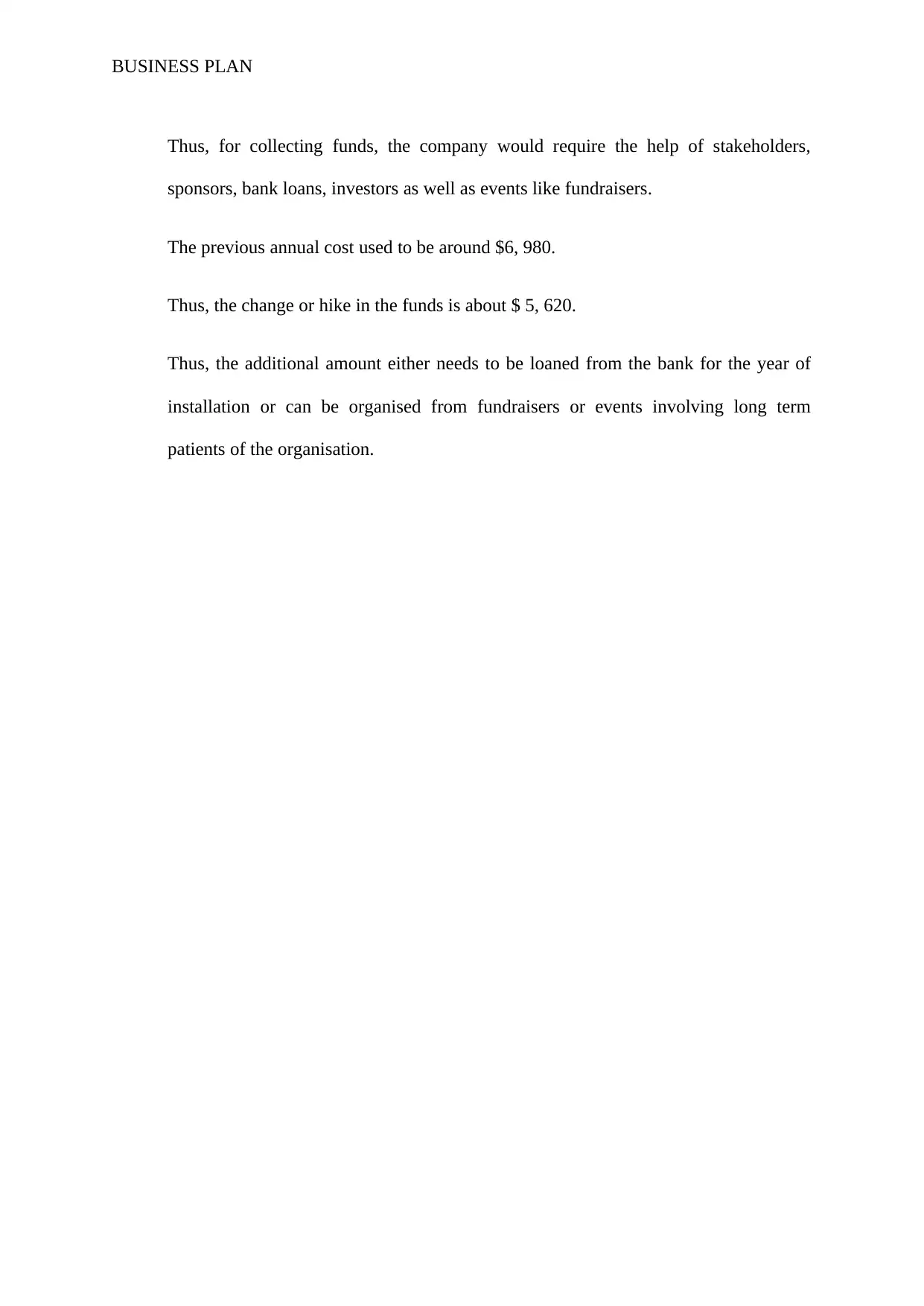
BUSINESS PLAN
Thus, for collecting funds, the company would require the help of stakeholders,
sponsors, bank loans, investors as well as events like fundraisers.
The previous annual cost used to be around $6, 980.
Thus, the change or hike in the funds is about $ 5, 620.
Thus, the additional amount either needs to be loaned from the bank for the year of
installation or can be organised from fundraisers or events involving long term
patients of the organisation.
Thus, for collecting funds, the company would require the help of stakeholders,
sponsors, bank loans, investors as well as events like fundraisers.
The previous annual cost used to be around $6, 980.
Thus, the change or hike in the funds is about $ 5, 620.
Thus, the additional amount either needs to be loaned from the bank for the year of
installation or can be organised from fundraisers or events involving long term
patients of the organisation.
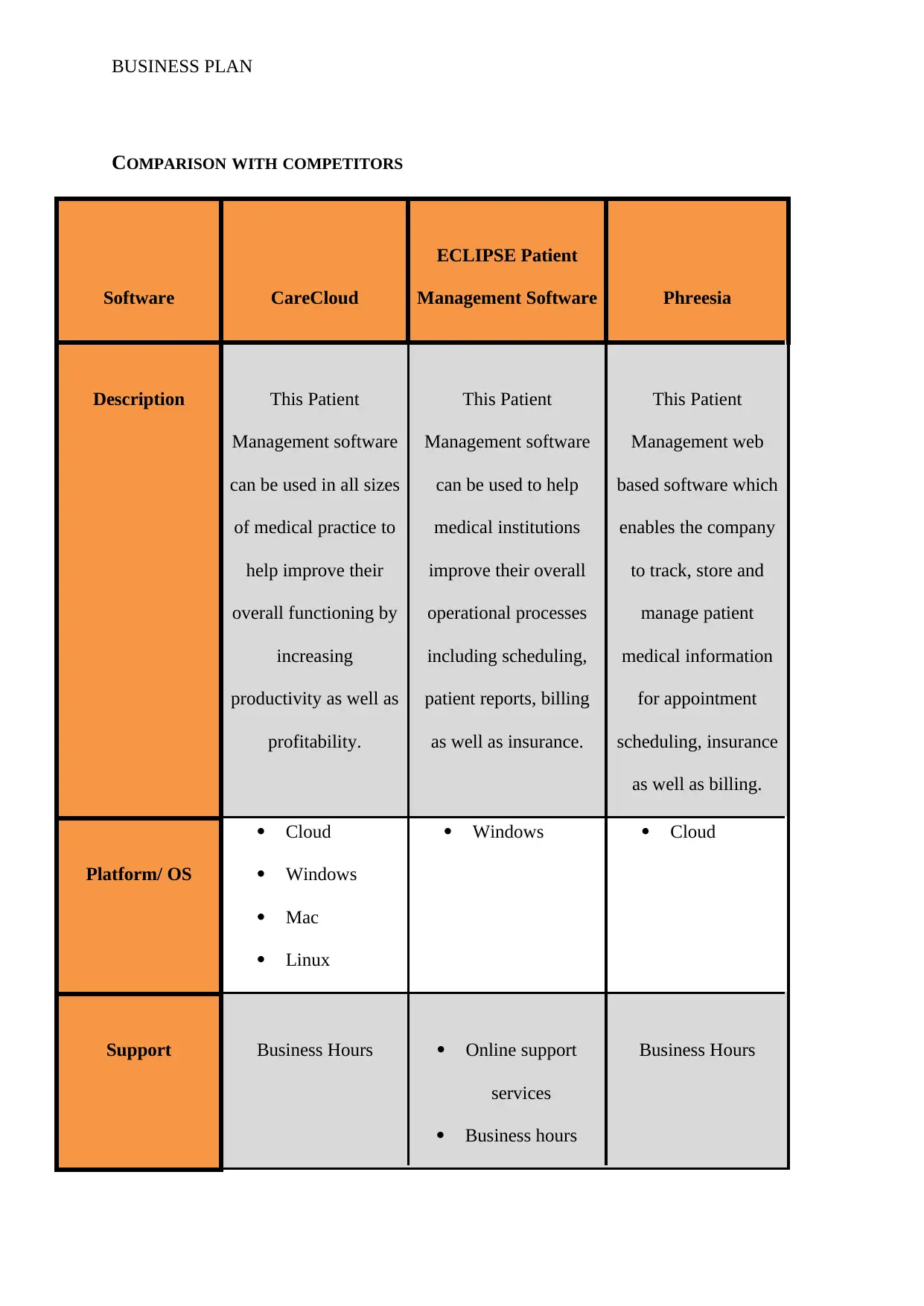
BUSINESS PLAN
COMPARISON WITH COMPETITORS
Software CareCloud
ECLIPSE Patient
Management Software Phreesia
Description This Patient
Management software
can be used in all sizes
of medical practice to
help improve their
overall functioning by
increasing
productivity as well as
profitability.
This Patient
Management software
can be used to help
medical institutions
improve their overall
operational processes
including scheduling,
patient reports, billing
as well as insurance.
This Patient
Management web
based software which
enables the company
to track, store and
manage patient
medical information
for appointment
scheduling, insurance
as well as billing.
Platform/ OS
Cloud
Windows
Mac
Linux
Windows Cloud
Support Business Hours Online support
services
Business hours
Business Hours
COMPARISON WITH COMPETITORS
Software CareCloud
ECLIPSE Patient
Management Software Phreesia
Description This Patient
Management software
can be used in all sizes
of medical practice to
help improve their
overall functioning by
increasing
productivity as well as
profitability.
This Patient
Management software
can be used to help
medical institutions
improve their overall
operational processes
including scheduling,
patient reports, billing
as well as insurance.
This Patient
Management web
based software which
enables the company
to track, store and
manage patient
medical information
for appointment
scheduling, insurance
as well as billing.
Platform/ OS
Cloud
Windows
Mac
Linux
Windows Cloud
Support Business Hours Online support
services
Business hours
Business Hours
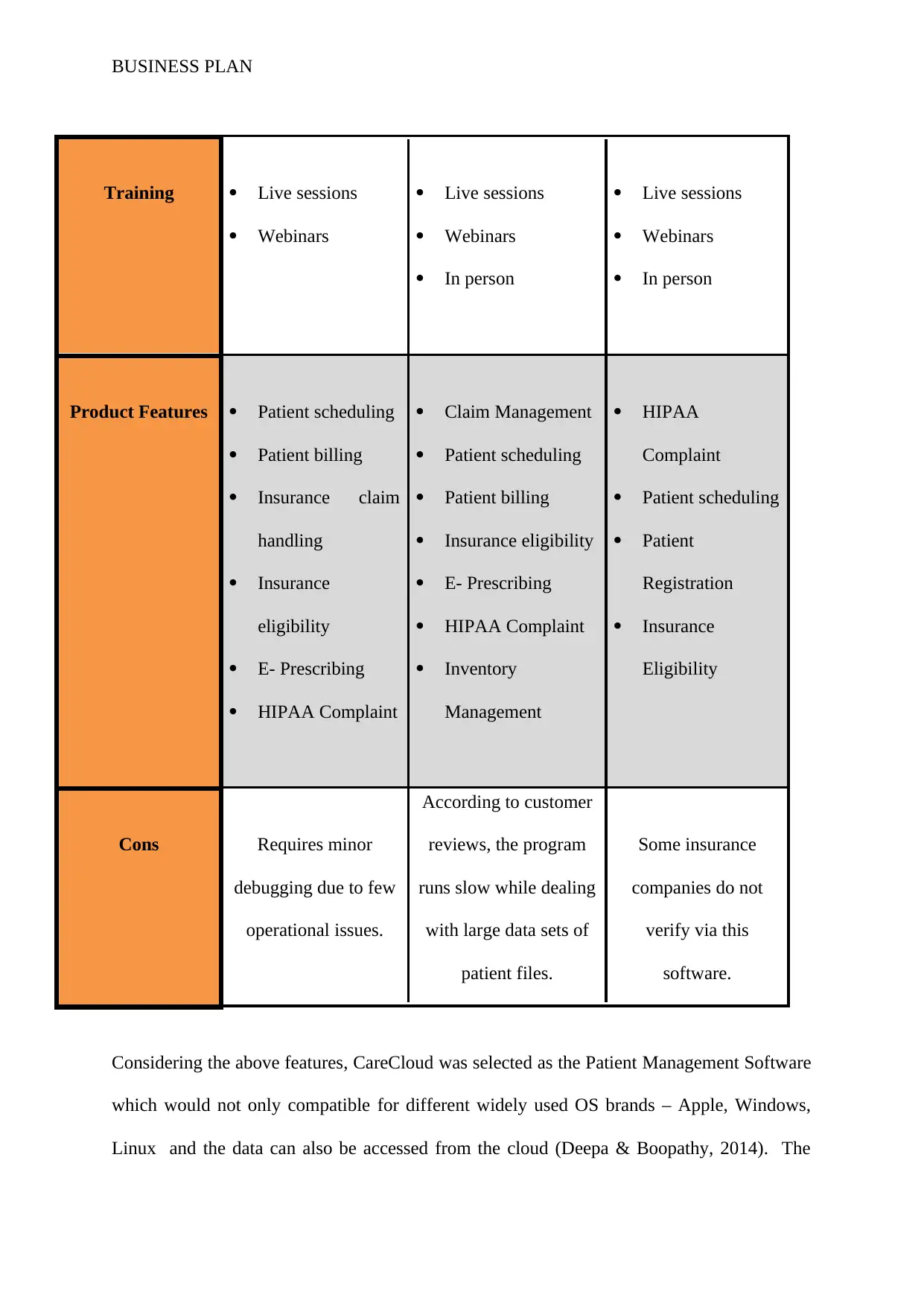
BUSINESS PLAN
Training Live sessions
Webinars
Live sessions
Webinars
In person
Live sessions
Webinars
In person
Product Features Patient scheduling
Patient billing
Insurance claim
handling
Insurance
eligibility
E- Prescribing
HIPAA Complaint
Claim Management
Patient scheduling
Patient billing
Insurance eligibility
E- Prescribing
HIPAA Complaint
Inventory
Management
HIPAA
Complaint
Patient scheduling
Patient
Registration
Insurance
Eligibility
Cons Requires minor
debugging due to few
operational issues.
According to customer
reviews, the program
runs slow while dealing
with large data sets of
patient files.
Some insurance
companies do not
verify via this
software.
Considering the above features, CareCloud was selected as the Patient Management Software
which would not only compatible for different widely used OS brands – Apple, Windows,
Linux and the data can also be accessed from the cloud (Deepa & Boopathy, 2014). The
Training Live sessions
Webinars
Live sessions
Webinars
In person
Live sessions
Webinars
In person
Product Features Patient scheduling
Patient billing
Insurance claim
handling
Insurance
eligibility
E- Prescribing
HIPAA Complaint
Claim Management
Patient scheduling
Patient billing
Insurance eligibility
E- Prescribing
HIPAA Complaint
Inventory
Management
HIPAA
Complaint
Patient scheduling
Patient
Registration
Insurance
Eligibility
Cons Requires minor
debugging due to few
operational issues.
According to customer
reviews, the program
runs slow while dealing
with large data sets of
patient files.
Some insurance
companies do not
verify via this
software.
Considering the above features, CareCloud was selected as the Patient Management Software
which would not only compatible for different widely used OS brands – Apple, Windows,
Linux and the data can also be accessed from the cloud (Deepa & Boopathy, 2014). The
Paraphrase This Document
Need a fresh take? Get an instant paraphrase of this document with our AI Paraphraser

BUSINESS PLAN
easy accessibility to patient information can be highly convenient in cases of emergency.
Moreover, the software will soon update to provide colour coded patient tabs to help
distinguish and identify better.
easy accessibility to patient information can be highly convenient in cases of emergency.
Moreover, the software will soon update to provide colour coded patient tabs to help
distinguish and identify better.
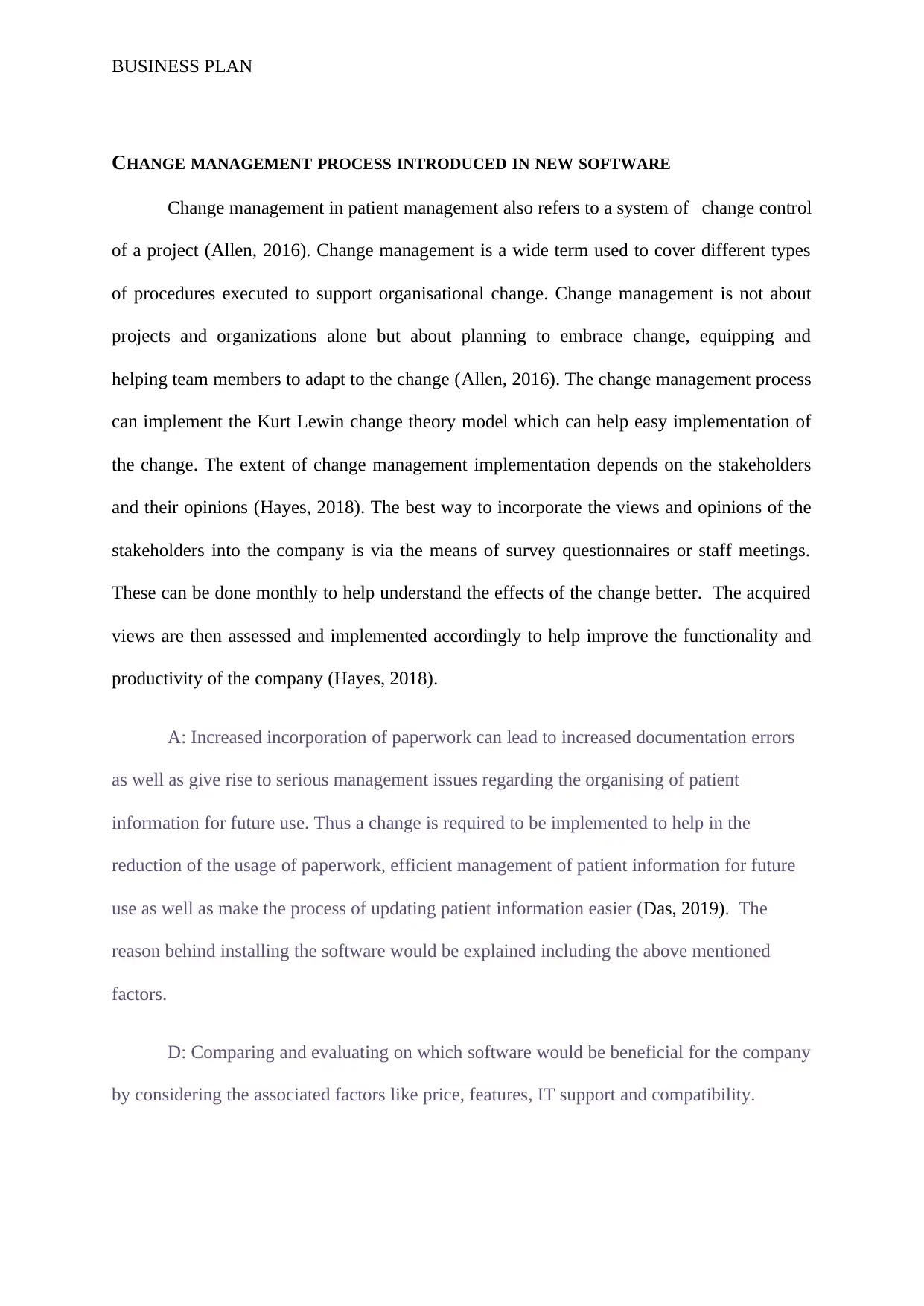
BUSINESS PLAN
CHANGE MANAGEMENT PROCESS INTRODUCED IN NEW SOFTWARE
Change management in patient management also refers to a system of change control
of a project (Allen, 2016). Change management is a wide term used to cover different types
of procedures executed to support organisational change. Change management is not about
projects and organizations alone but about planning to embrace change, equipping and
helping team members to adapt to the change (Allen, 2016). The change management process
can implement the Kurt Lewin change theory model which can help easy implementation of
the change. The extent of change management implementation depends on the stakeholders
and their opinions (Hayes, 2018). The best way to incorporate the views and opinions of the
stakeholders into the company is via the means of survey questionnaires or staff meetings.
These can be done monthly to help understand the effects of the change better. The acquired
views are then assessed and implemented accordingly to help improve the functionality and
productivity of the company (Hayes, 2018).
A: Increased incorporation of paperwork can lead to increased documentation errors
as well as give rise to serious management issues regarding the organising of patient
information for future use. Thus a change is required to be implemented to help in the
reduction of the usage of paperwork, efficient management of patient information for future
use as well as make the process of updating patient information easier (Das, 2019). The
reason behind installing the software would be explained including the above mentioned
factors.
D: Comparing and evaluating on which software would be beneficial for the company
by considering the associated factors like price, features, IT support and compatibility.
CHANGE MANAGEMENT PROCESS INTRODUCED IN NEW SOFTWARE
Change management in patient management also refers to a system of change control
of a project (Allen, 2016). Change management is a wide term used to cover different types
of procedures executed to support organisational change. Change management is not about
projects and organizations alone but about planning to embrace change, equipping and
helping team members to adapt to the change (Allen, 2016). The change management process
can implement the Kurt Lewin change theory model which can help easy implementation of
the change. The extent of change management implementation depends on the stakeholders
and their opinions (Hayes, 2018). The best way to incorporate the views and opinions of the
stakeholders into the company is via the means of survey questionnaires or staff meetings.
These can be done monthly to help understand the effects of the change better. The acquired
views are then assessed and implemented accordingly to help improve the functionality and
productivity of the company (Hayes, 2018).
A: Increased incorporation of paperwork can lead to increased documentation errors
as well as give rise to serious management issues regarding the organising of patient
information for future use. Thus a change is required to be implemented to help in the
reduction of the usage of paperwork, efficient management of patient information for future
use as well as make the process of updating patient information easier (Das, 2019). The
reason behind installing the software would be explained including the above mentioned
factors.
D: Comparing and evaluating on which software would be beneficial for the company
by considering the associated factors like price, features, IT support and compatibility.
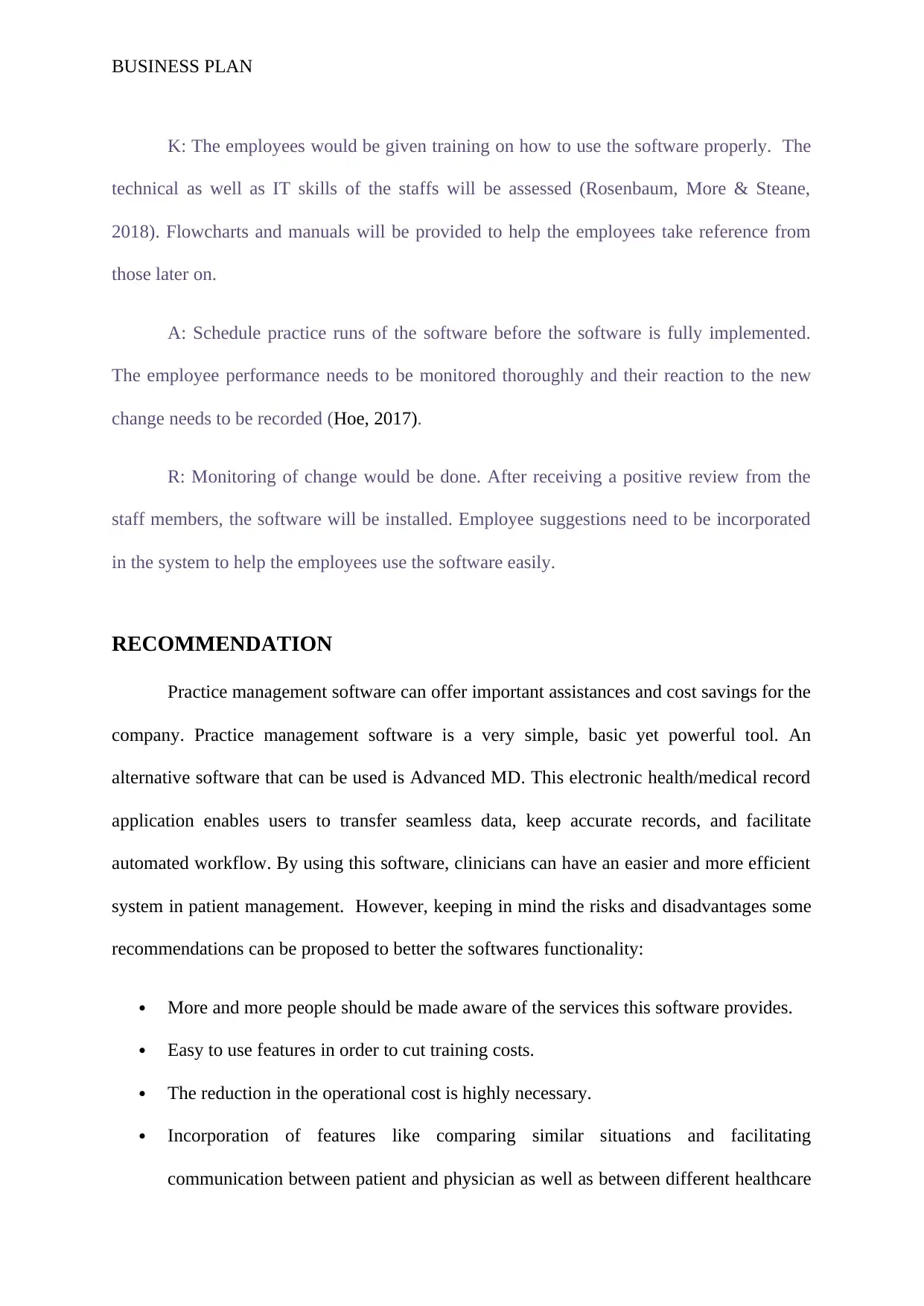
BUSINESS PLAN
K: The employees would be given training on how to use the software properly. The
technical as well as IT skills of the staffs will be assessed (Rosenbaum, More & Steane,
2018). Flowcharts and manuals will be provided to help the employees take reference from
those later on.
A: Schedule practice runs of the software before the software is fully implemented.
The employee performance needs to be monitored thoroughly and their reaction to the new
change needs to be recorded (Hoe, 2017).
R: Monitoring of change would be done. After receiving a positive review from the
staff members, the software will be installed. Employee suggestions need to be incorporated
in the system to help the employees use the software easily.
RECOMMENDATION
Practice management software can offer important assistances and cost savings for the
company. Practice management software is a very simple, basic yet powerful tool. An
alternative software that can be used is Advanced MD. This electronic health/medical record
application enables users to transfer seamless data, keep accurate records, and facilitate
automated workflow. By using this software, clinicians can have an easier and more efficient
system in patient management. However, keeping in mind the risks and disadvantages some
recommendations can be proposed to better the softwares functionality:
More and more people should be made aware of the services this software provides.
Easy to use features in order to cut training costs.
The reduction in the operational cost is highly necessary.
Incorporation of features like comparing similar situations and facilitating
communication between patient and physician as well as between different healthcare
K: The employees would be given training on how to use the software properly. The
technical as well as IT skills of the staffs will be assessed (Rosenbaum, More & Steane,
2018). Flowcharts and manuals will be provided to help the employees take reference from
those later on.
A: Schedule practice runs of the software before the software is fully implemented.
The employee performance needs to be monitored thoroughly and their reaction to the new
change needs to be recorded (Hoe, 2017).
R: Monitoring of change would be done. After receiving a positive review from the
staff members, the software will be installed. Employee suggestions need to be incorporated
in the system to help the employees use the software easily.
RECOMMENDATION
Practice management software can offer important assistances and cost savings for the
company. Practice management software is a very simple, basic yet powerful tool. An
alternative software that can be used is Advanced MD. This electronic health/medical record
application enables users to transfer seamless data, keep accurate records, and facilitate
automated workflow. By using this software, clinicians can have an easier and more efficient
system in patient management. However, keeping in mind the risks and disadvantages some
recommendations can be proposed to better the softwares functionality:
More and more people should be made aware of the services this software provides.
Easy to use features in order to cut training costs.
The reduction in the operational cost is highly necessary.
Incorporation of features like comparing similar situations and facilitating
communication between patient and physician as well as between different healthcare
Secure Best Marks with AI Grader
Need help grading? Try our AI Grader for instant feedback on your assignments.
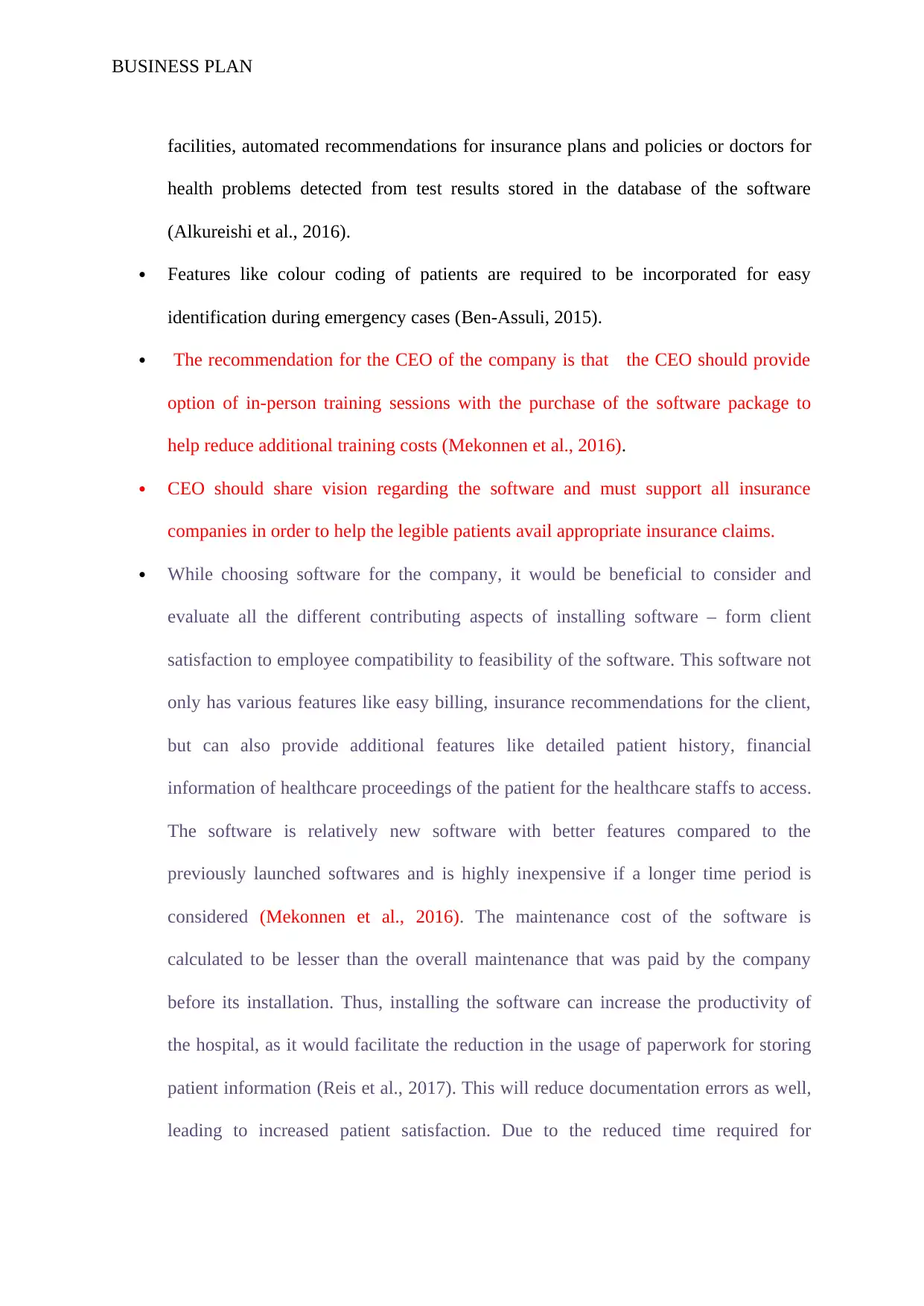
BUSINESS PLAN
facilities, automated recommendations for insurance plans and policies or doctors for
health problems detected from test results stored in the database of the software
(Alkureishi et al., 2016).
Features like colour coding of patients are required to be incorporated for easy
identification during emergency cases (Ben-Assuli, 2015).
The recommendation for the CEO of the company is that the CEO should provide
option of in-person training sessions with the purchase of the software package to
help reduce additional training costs (Mekonnen et al., 2016).
CEO should share vision regarding the software and must support all insurance
companies in order to help the legible patients avail appropriate insurance claims.
While choosing software for the company, it would be beneficial to consider and
evaluate all the different contributing aspects of installing software – form client
satisfaction to employee compatibility to feasibility of the software. This software not
only has various features like easy billing, insurance recommendations for the client,
but can also provide additional features like detailed patient history, financial
information of healthcare proceedings of the patient for the healthcare staffs to access.
The software is relatively new software with better features compared to the
previously launched softwares and is highly inexpensive if a longer time period is
considered (Mekonnen et al., 2016). The maintenance cost of the software is
calculated to be lesser than the overall maintenance that was paid by the company
before its installation. Thus, installing the software can increase the productivity of
the hospital, as it would facilitate the reduction in the usage of paperwork for storing
patient information (Reis et al., 2017). This will reduce documentation errors as well,
leading to increased patient satisfaction. Due to the reduced time required for
facilities, automated recommendations for insurance plans and policies or doctors for
health problems detected from test results stored in the database of the software
(Alkureishi et al., 2016).
Features like colour coding of patients are required to be incorporated for easy
identification during emergency cases (Ben-Assuli, 2015).
The recommendation for the CEO of the company is that the CEO should provide
option of in-person training sessions with the purchase of the software package to
help reduce additional training costs (Mekonnen et al., 2016).
CEO should share vision regarding the software and must support all insurance
companies in order to help the legible patients avail appropriate insurance claims.
While choosing software for the company, it would be beneficial to consider and
evaluate all the different contributing aspects of installing software – form client
satisfaction to employee compatibility to feasibility of the software. This software not
only has various features like easy billing, insurance recommendations for the client,
but can also provide additional features like detailed patient history, financial
information of healthcare proceedings of the patient for the healthcare staffs to access.
The software is relatively new software with better features compared to the
previously launched softwares and is highly inexpensive if a longer time period is
considered (Mekonnen et al., 2016). The maintenance cost of the software is
calculated to be lesser than the overall maintenance that was paid by the company
before its installation. Thus, installing the software can increase the productivity of
the hospital, as it would facilitate the reduction in the usage of paperwork for storing
patient information (Reis et al., 2017). This will reduce documentation errors as well,
leading to increased patient satisfaction. Due to the reduced time required for
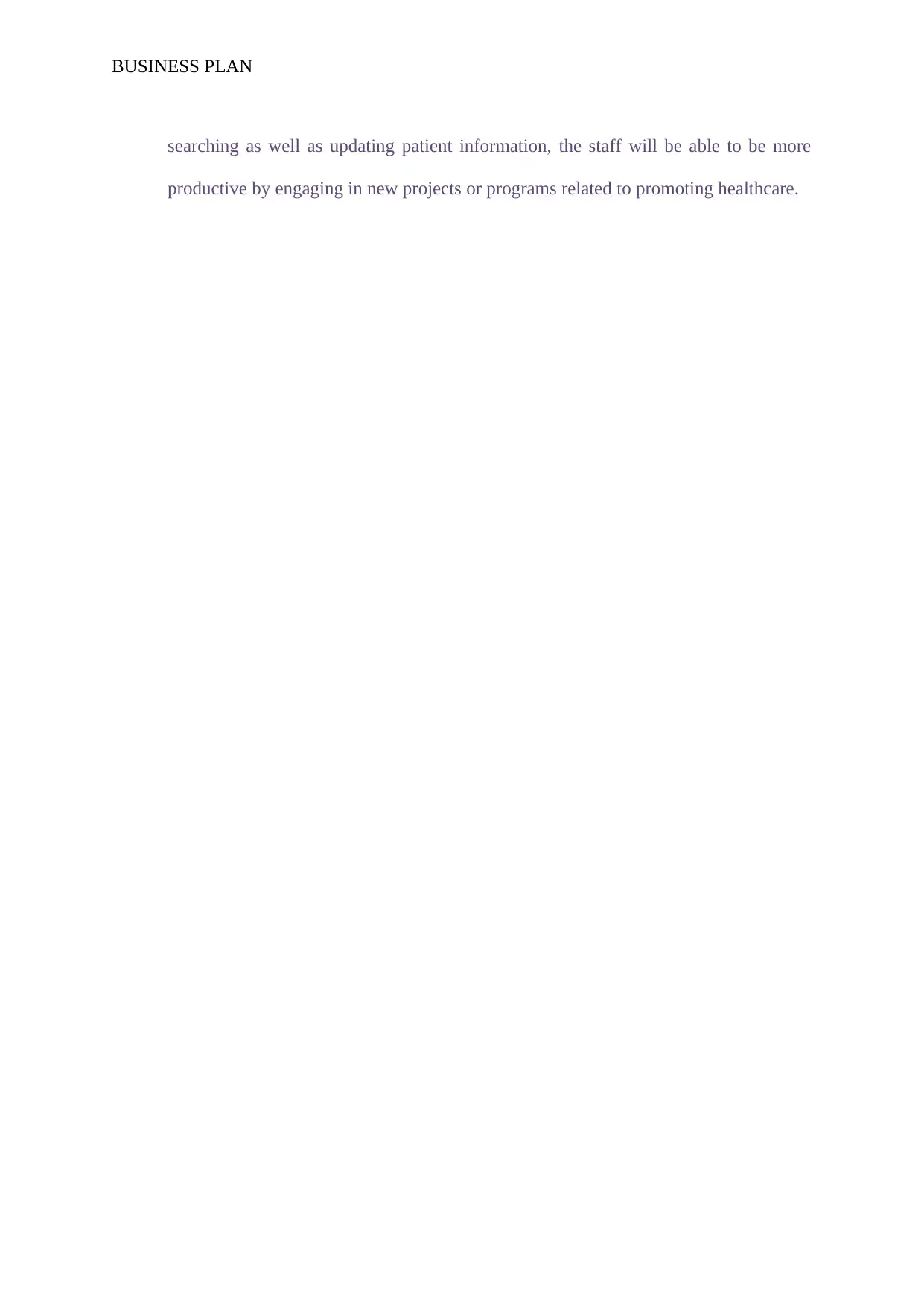
BUSINESS PLAN
searching as well as updating patient information, the staff will be able to be more
productive by engaging in new projects or programs related to promoting healthcare.
searching as well as updating patient information, the staff will be able to be more
productive by engaging in new projects or programs related to promoting healthcare.
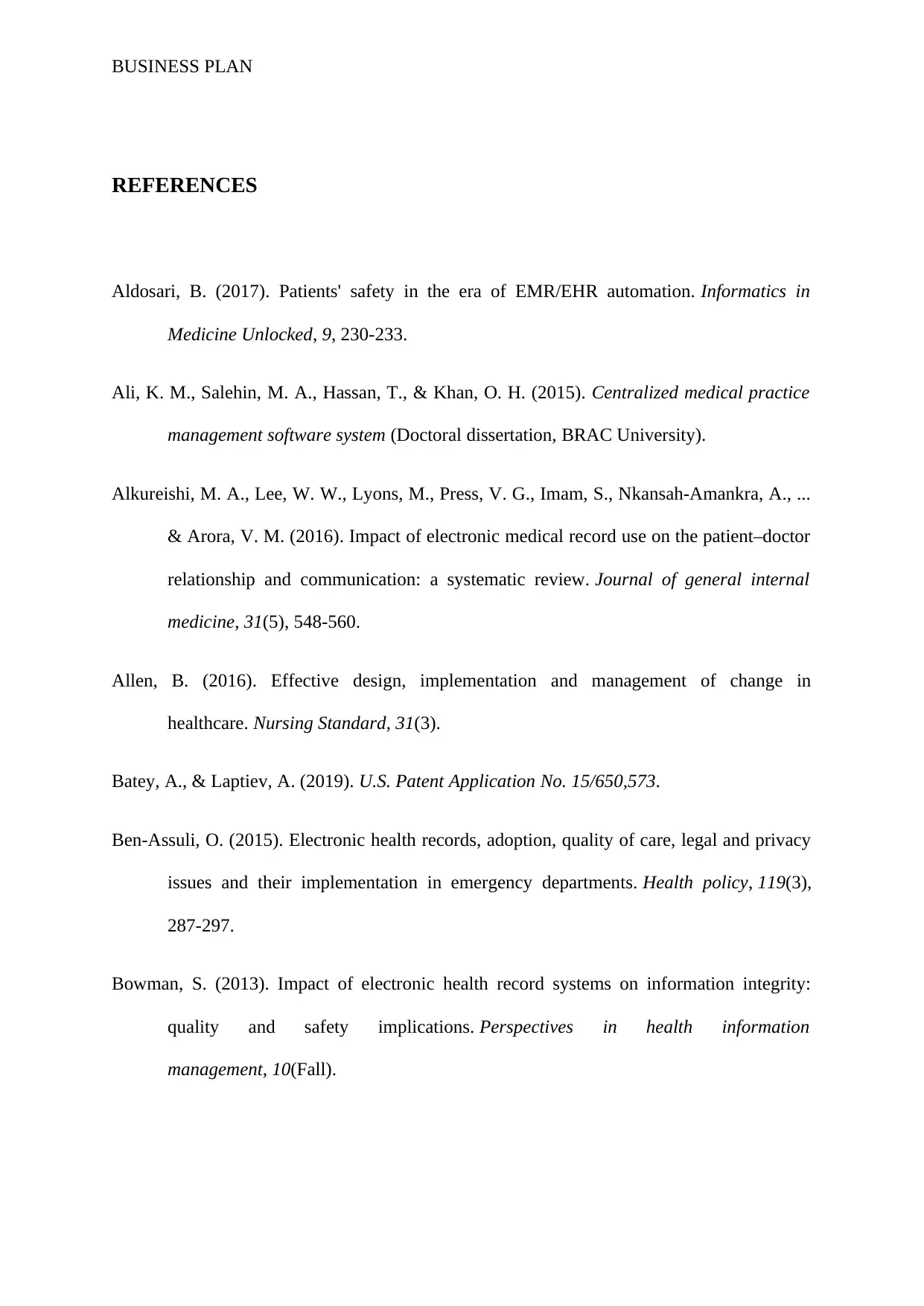
BUSINESS PLAN
REFERENCES
Aldosari, B. (2017). Patients' safety in the era of EMR/EHR automation. Informatics in
Medicine Unlocked, 9, 230-233.
Ali, K. M., Salehin, M. A., Hassan, T., & Khan, O. H. (2015). Centralized medical practice
management software system (Doctoral dissertation, BRAC University).
Alkureishi, M. A., Lee, W. W., Lyons, M., Press, V. G., Imam, S., Nkansah-Amankra, A., ...
& Arora, V. M. (2016). Impact of electronic medical record use on the patient–doctor
relationship and communication: a systematic review. Journal of general internal
medicine, 31(5), 548-560.
Allen, B. (2016). Effective design, implementation and management of change in
healthcare. Nursing Standard, 31(3).
Batey, A., & Laptiev, A. (2019). U.S. Patent Application No. 15/650,573.
Ben-Assuli, O. (2015). Electronic health records, adoption, quality of care, legal and privacy
issues and their implementation in emergency departments. Health policy, 119(3),
287-297.
Bowman, S. (2013). Impact of electronic health record systems on information integrity:
quality and safety implications. Perspectives in health information
management, 10(Fall).
REFERENCES
Aldosari, B. (2017). Patients' safety in the era of EMR/EHR automation. Informatics in
Medicine Unlocked, 9, 230-233.
Ali, K. M., Salehin, M. A., Hassan, T., & Khan, O. H. (2015). Centralized medical practice
management software system (Doctoral dissertation, BRAC University).
Alkureishi, M. A., Lee, W. W., Lyons, M., Press, V. G., Imam, S., Nkansah-Amankra, A., ...
& Arora, V. M. (2016). Impact of electronic medical record use on the patient–doctor
relationship and communication: a systematic review. Journal of general internal
medicine, 31(5), 548-560.
Allen, B. (2016). Effective design, implementation and management of change in
healthcare. Nursing Standard, 31(3).
Batey, A., & Laptiev, A. (2019). U.S. Patent Application No. 15/650,573.
Ben-Assuli, O. (2015). Electronic health records, adoption, quality of care, legal and privacy
issues and their implementation in emergency departments. Health policy, 119(3),
287-297.
Bowman, S. (2013). Impact of electronic health record systems on information integrity:
quality and safety implications. Perspectives in health information
management, 10(Fall).
Paraphrase This Document
Need a fresh take? Get an instant paraphrase of this document with our AI Paraphraser
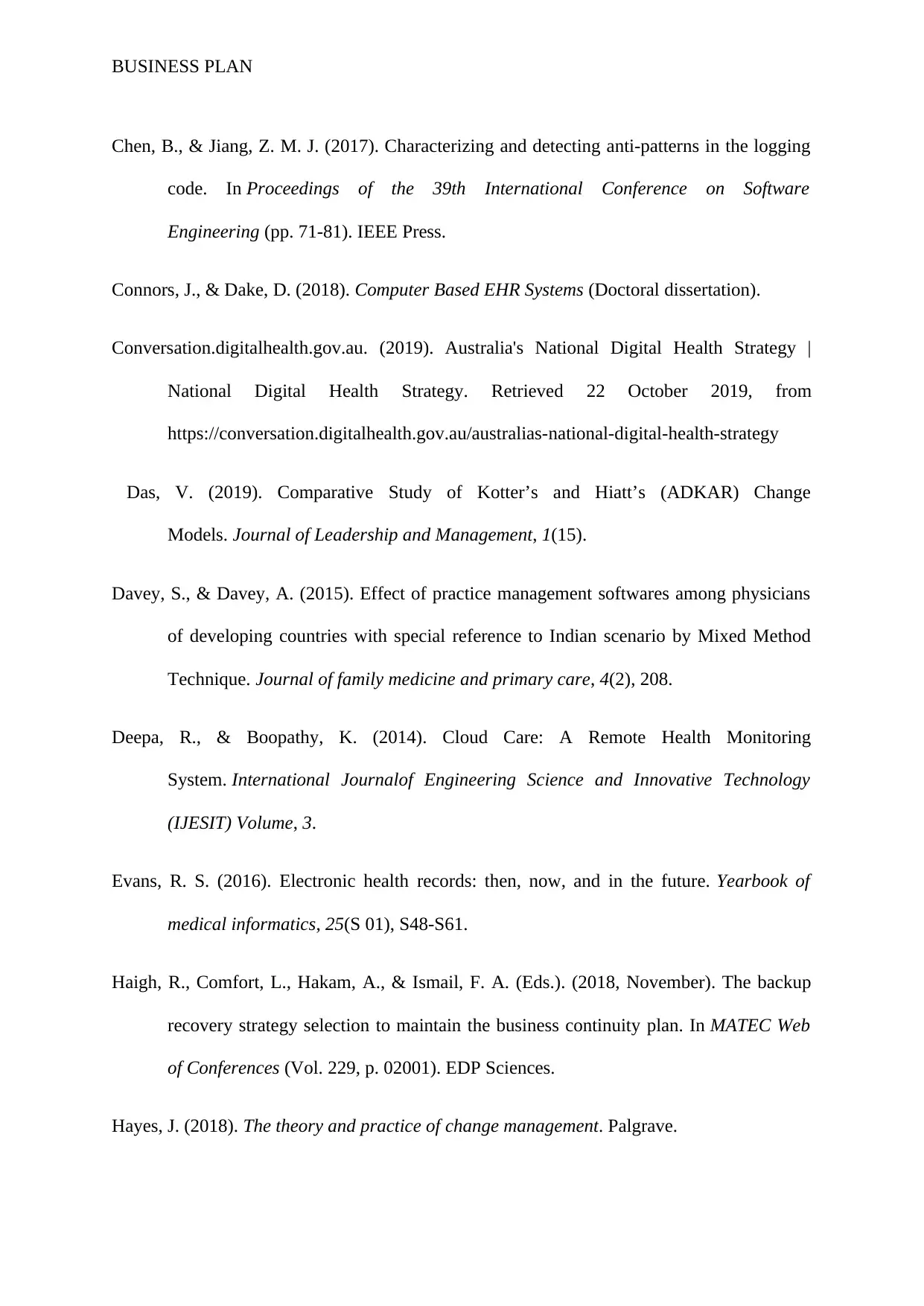
BUSINESS PLAN
Chen, B., & Jiang, Z. M. J. (2017). Characterizing and detecting anti-patterns in the logging
code. In Proceedings of the 39th International Conference on Software
Engineering (pp. 71-81). IEEE Press.
Connors, J., & Dake, D. (2018). Computer Based EHR Systems (Doctoral dissertation).
Conversation.digitalhealth.gov.au. (2019). Australia's National Digital Health Strategy |
National Digital Health Strategy. Retrieved 22 October 2019, from
https://conversation.digitalhealth.gov.au/australias-national-digital-health-strategy
Das, V. (2019). Comparative Study of Kotter’s and Hiatt’s (ADKAR) Change
Models. Journal of Leadership and Management, 1(15).
Davey, S., & Davey, A. (2015). Effect of practice management softwares among physicians
of developing countries with special reference to Indian scenario by Mixed Method
Technique. Journal of family medicine and primary care, 4(2), 208.
Deepa, R., & Boopathy, K. (2014). Cloud Care: A Remote Health Monitoring
System. International Journalof Engineering Science and Innovative Technology
(IJESIT) Volume, 3.
Evans, R. S. (2016). Electronic health records: then, now, and in the future. Yearbook of
medical informatics, 25(S 01), S48-S61.
Haigh, R., Comfort, L., Hakam, A., & Ismail, F. A. (Eds.). (2018, November). The backup
recovery strategy selection to maintain the business continuity plan. In MATEC Web
of Conferences (Vol. 229, p. 02001). EDP Sciences.
Hayes, J. (2018). The theory and practice of change management. Palgrave.
Chen, B., & Jiang, Z. M. J. (2017). Characterizing and detecting anti-patterns in the logging
code. In Proceedings of the 39th International Conference on Software
Engineering (pp. 71-81). IEEE Press.
Connors, J., & Dake, D. (2018). Computer Based EHR Systems (Doctoral dissertation).
Conversation.digitalhealth.gov.au. (2019). Australia's National Digital Health Strategy |
National Digital Health Strategy. Retrieved 22 October 2019, from
https://conversation.digitalhealth.gov.au/australias-national-digital-health-strategy
Das, V. (2019). Comparative Study of Kotter’s and Hiatt’s (ADKAR) Change
Models. Journal of Leadership and Management, 1(15).
Davey, S., & Davey, A. (2015). Effect of practice management softwares among physicians
of developing countries with special reference to Indian scenario by Mixed Method
Technique. Journal of family medicine and primary care, 4(2), 208.
Deepa, R., & Boopathy, K. (2014). Cloud Care: A Remote Health Monitoring
System. International Journalof Engineering Science and Innovative Technology
(IJESIT) Volume, 3.
Evans, R. S. (2016). Electronic health records: then, now, and in the future. Yearbook of
medical informatics, 25(S 01), S48-S61.
Haigh, R., Comfort, L., Hakam, A., & Ismail, F. A. (Eds.). (2018, November). The backup
recovery strategy selection to maintain the business continuity plan. In MATEC Web
of Conferences (Vol. 229, p. 02001). EDP Sciences.
Hayes, J. (2018). The theory and practice of change management. Palgrave.
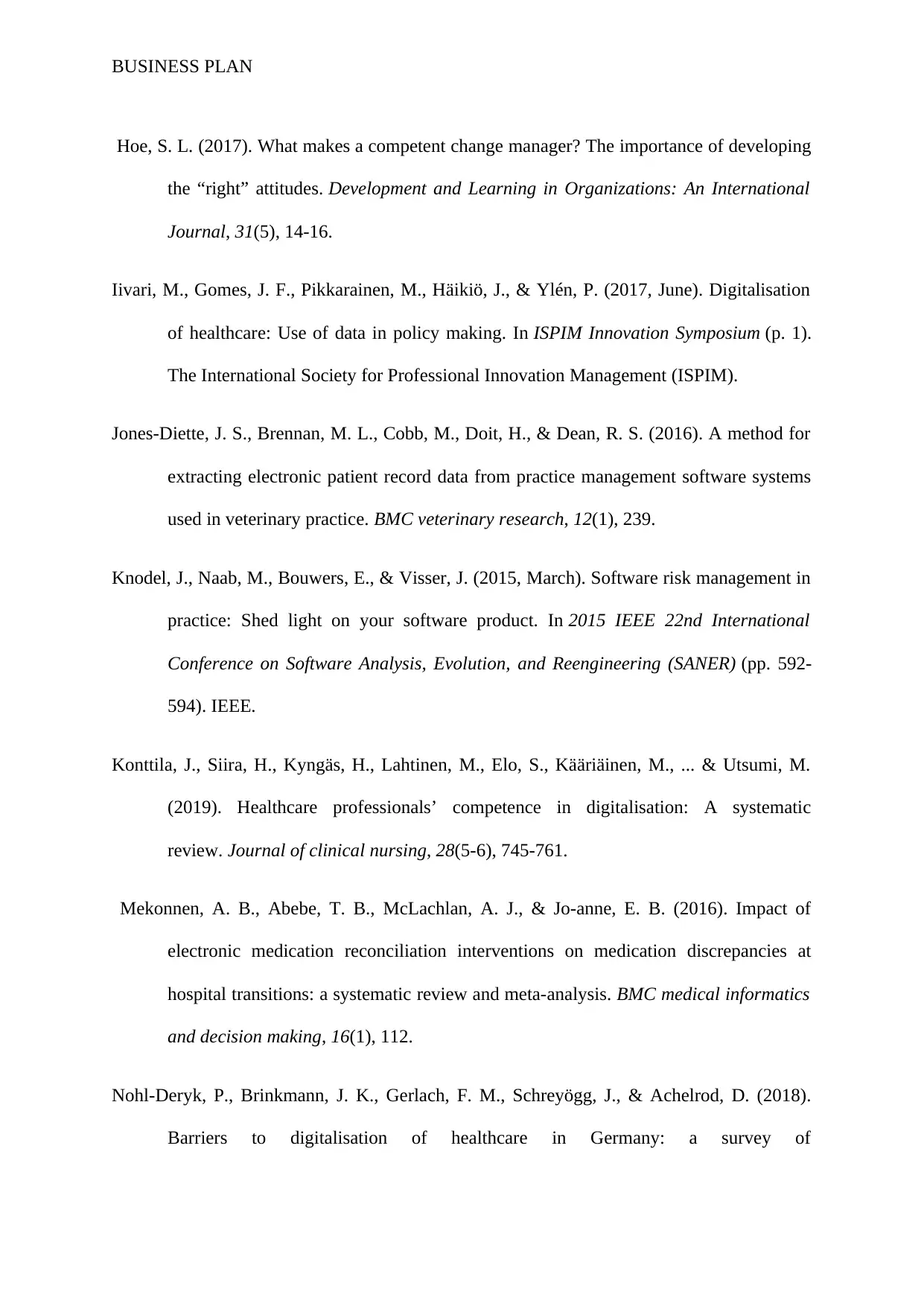
BUSINESS PLAN
Hoe, S. L. (2017). What makes a competent change manager? The importance of developing
the “right” attitudes. Development and Learning in Organizations: An International
Journal, 31(5), 14-16.
Iivari, M., Gomes, J. F., Pikkarainen, M., Häikiö, J., & Ylén, P. (2017, June). Digitalisation
of healthcare: Use of data in policy making. In ISPIM Innovation Symposium (p. 1).
The International Society for Professional Innovation Management (ISPIM).
Jones-Diette, J. S., Brennan, M. L., Cobb, M., Doit, H., & Dean, R. S. (2016). A method for
extracting electronic patient record data from practice management software systems
used in veterinary practice. BMC veterinary research, 12(1), 239.
Knodel, J., Naab, M., Bouwers, E., & Visser, J. (2015, March). Software risk management in
practice: Shed light on your software product. In 2015 IEEE 22nd International
Conference on Software Analysis, Evolution, and Reengineering (SANER) (pp. 592-
594). IEEE.
Konttila, J., Siira, H., Kyngäs, H., Lahtinen, M., Elo, S., Kääriäinen, M., ... & Utsumi, M.
(2019). Healthcare professionals’ competence in digitalisation: A systematic
review. Journal of clinical nursing, 28(5-6), 745-761.
Mekonnen, A. B., Abebe, T. B., McLachlan, A. J., & Jo-anne, E. B. (2016). Impact of
electronic medication reconciliation interventions on medication discrepancies at
hospital transitions: a systematic review and meta-analysis. BMC medical informatics
and decision making, 16(1), 112.
Nohl-Deryk, P., Brinkmann, J. K., Gerlach, F. M., Schreyögg, J., & Achelrod, D. (2018).
Barriers to digitalisation of healthcare in Germany: a survey of
Hoe, S. L. (2017). What makes a competent change manager? The importance of developing
the “right” attitudes. Development and Learning in Organizations: An International
Journal, 31(5), 14-16.
Iivari, M., Gomes, J. F., Pikkarainen, M., Häikiö, J., & Ylén, P. (2017, June). Digitalisation
of healthcare: Use of data in policy making. In ISPIM Innovation Symposium (p. 1).
The International Society for Professional Innovation Management (ISPIM).
Jones-Diette, J. S., Brennan, M. L., Cobb, M., Doit, H., & Dean, R. S. (2016). A method for
extracting electronic patient record data from practice management software systems
used in veterinary practice. BMC veterinary research, 12(1), 239.
Knodel, J., Naab, M., Bouwers, E., & Visser, J. (2015, March). Software risk management in
practice: Shed light on your software product. In 2015 IEEE 22nd International
Conference on Software Analysis, Evolution, and Reengineering (SANER) (pp. 592-
594). IEEE.
Konttila, J., Siira, H., Kyngäs, H., Lahtinen, M., Elo, S., Kääriäinen, M., ... & Utsumi, M.
(2019). Healthcare professionals’ competence in digitalisation: A systematic
review. Journal of clinical nursing, 28(5-6), 745-761.
Mekonnen, A. B., Abebe, T. B., McLachlan, A. J., & Jo-anne, E. B. (2016). Impact of
electronic medication reconciliation interventions on medication discrepancies at
hospital transitions: a systematic review and meta-analysis. BMC medical informatics
and decision making, 16(1), 112.
Nohl-Deryk, P., Brinkmann, J. K., Gerlach, F. M., Schreyögg, J., & Achelrod, D. (2018).
Barriers to digitalisation of healthcare in Germany: a survey of
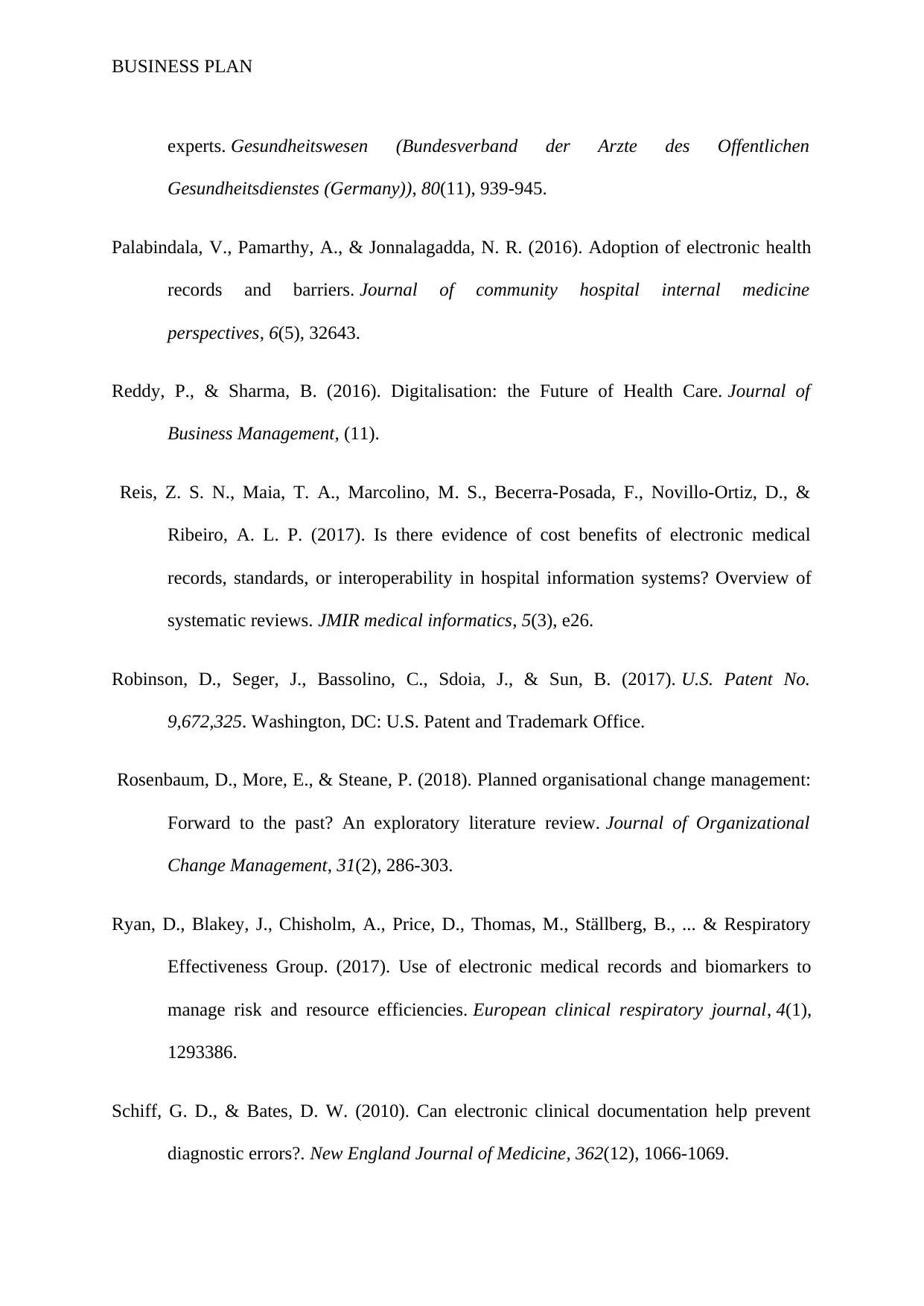
BUSINESS PLAN
experts. Gesundheitswesen (Bundesverband der Arzte des Offentlichen
Gesundheitsdienstes (Germany)), 80(11), 939-945.
Palabindala, V., Pamarthy, A., & Jonnalagadda, N. R. (2016). Adoption of electronic health
records and barriers. Journal of community hospital internal medicine
perspectives, 6(5), 32643.
Reddy, P., & Sharma, B. (2016). Digitalisation: the Future of Health Care. Journal of
Business Management, (11).
Reis, Z. S. N., Maia, T. A., Marcolino, M. S., Becerra-Posada, F., Novillo-Ortiz, D., &
Ribeiro, A. L. P. (2017). Is there evidence of cost benefits of electronic medical
records, standards, or interoperability in hospital information systems? Overview of
systematic reviews. JMIR medical informatics, 5(3), e26.
Robinson, D., Seger, J., Bassolino, C., Sdoia, J., & Sun, B. (2017). U.S. Patent No.
9,672,325. Washington, DC: U.S. Patent and Trademark Office.
Rosenbaum, D., More, E., & Steane, P. (2018). Planned organisational change management:
Forward to the past? An exploratory literature review. Journal of Organizational
Change Management, 31(2), 286-303.
Ryan, D., Blakey, J., Chisholm, A., Price, D., Thomas, M., Ställberg, B., ... & Respiratory
Effectiveness Group. (2017). Use of electronic medical records and biomarkers to
manage risk and resource efficiencies. European clinical respiratory journal, 4(1),
1293386.
Schiff, G. D., & Bates, D. W. (2010). Can electronic clinical documentation help prevent
diagnostic errors?. New England Journal of Medicine, 362(12), 1066-1069.
experts. Gesundheitswesen (Bundesverband der Arzte des Offentlichen
Gesundheitsdienstes (Germany)), 80(11), 939-945.
Palabindala, V., Pamarthy, A., & Jonnalagadda, N. R. (2016). Adoption of electronic health
records and barriers. Journal of community hospital internal medicine
perspectives, 6(5), 32643.
Reddy, P., & Sharma, B. (2016). Digitalisation: the Future of Health Care. Journal of
Business Management, (11).
Reis, Z. S. N., Maia, T. A., Marcolino, M. S., Becerra-Posada, F., Novillo-Ortiz, D., &
Ribeiro, A. L. P. (2017). Is there evidence of cost benefits of electronic medical
records, standards, or interoperability in hospital information systems? Overview of
systematic reviews. JMIR medical informatics, 5(3), e26.
Robinson, D., Seger, J., Bassolino, C., Sdoia, J., & Sun, B. (2017). U.S. Patent No.
9,672,325. Washington, DC: U.S. Patent and Trademark Office.
Rosenbaum, D., More, E., & Steane, P. (2018). Planned organisational change management:
Forward to the past? An exploratory literature review. Journal of Organizational
Change Management, 31(2), 286-303.
Ryan, D., Blakey, J., Chisholm, A., Price, D., Thomas, M., Ställberg, B., ... & Respiratory
Effectiveness Group. (2017). Use of electronic medical records and biomarkers to
manage risk and resource efficiencies. European clinical respiratory journal, 4(1),
1293386.
Schiff, G. D., & Bates, D. W. (2010). Can electronic clinical documentation help prevent
diagnostic errors?. New England Journal of Medicine, 362(12), 1066-1069.
Secure Best Marks with AI Grader
Need help grading? Try our AI Grader for instant feedback on your assignments.
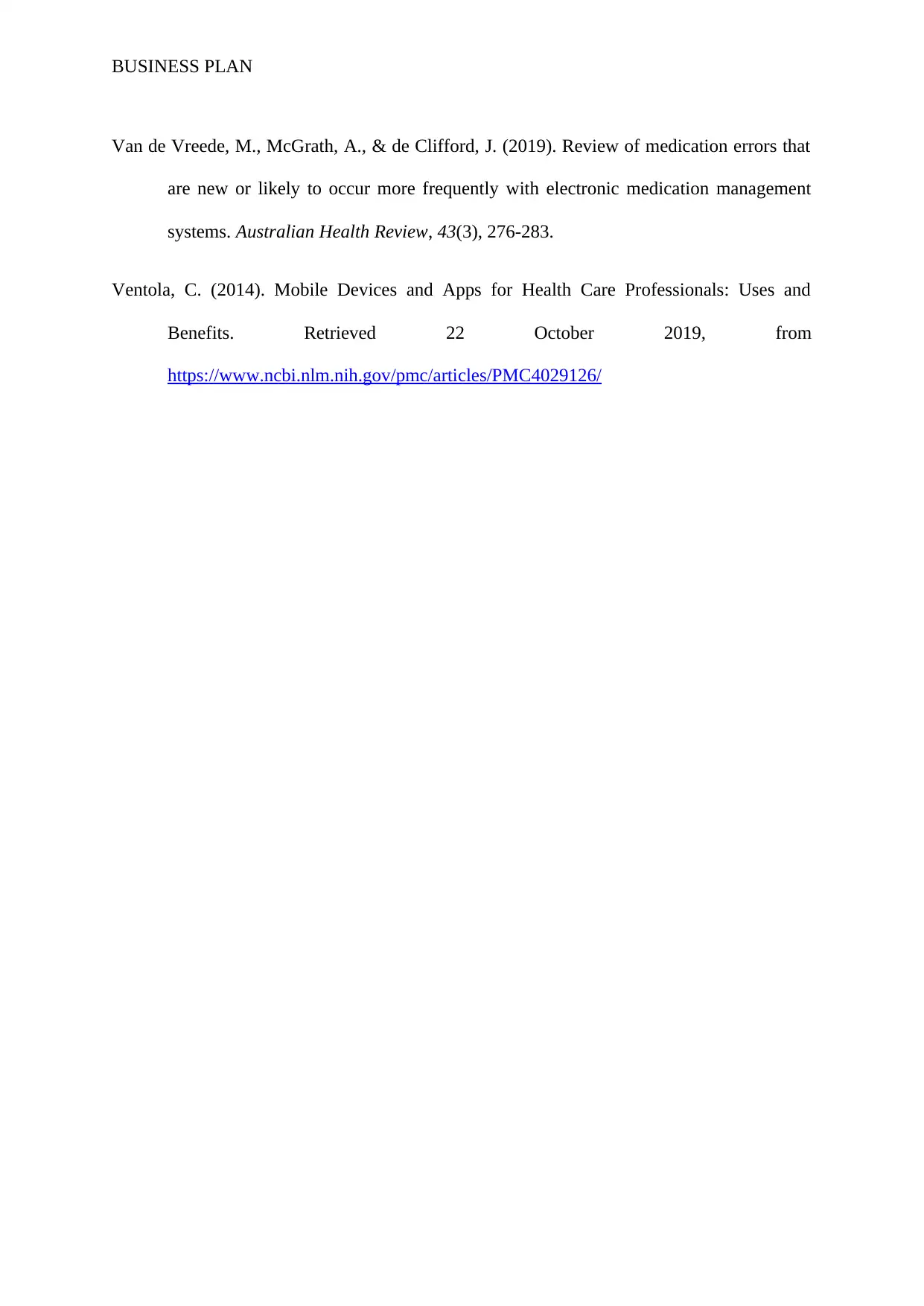
BUSINESS PLAN
Van de Vreede, M., McGrath, A., & de Clifford, J. (2019). Review of medication errors that
are new or likely to occur more frequently with electronic medication management
systems. Australian Health Review, 43(3), 276-283.
Ventola, C. (2014). Mobile Devices and Apps for Health Care Professionals: Uses and
Benefits. Retrieved 22 October 2019, from
https://www.ncbi.nlm.nih.gov/pmc/articles/PMC4029126/
Van de Vreede, M., McGrath, A., & de Clifford, J. (2019). Review of medication errors that
are new or likely to occur more frequently with electronic medication management
systems. Australian Health Review, 43(3), 276-283.
Ventola, C. (2014). Mobile Devices and Apps for Health Care Professionals: Uses and
Benefits. Retrieved 22 October 2019, from
https://www.ncbi.nlm.nih.gov/pmc/articles/PMC4029126/
1 out of 29
Related Documents
Your All-in-One AI-Powered Toolkit for Academic Success.
+13062052269
info@desklib.com
Available 24*7 on WhatsApp / Email
![[object Object]](/_next/static/media/star-bottom.7253800d.svg)
Unlock your academic potential
© 2024 | Zucol Services PVT LTD | All rights reserved.





